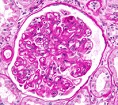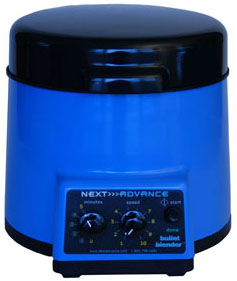Ideal for Tissue Samples |
 |
|
Save Time, Effort and Get Superior Results with |
||
 |
|
|
 |
| Do you spend lots of time and effort homogenizing tissue samples? The Bullet Blender® is a multi-sample homogenizer that delivers high quality and superior yields. No other homogenizer comes close to delivering the Bullet Blender’s winning combination of top-quality performance and budget-friendly affordability. | |
|
|
Bullet Blender settings for Tissue Homogenization
Sample size |
See the Protocol |
| microcentrifuge tube model (up to 300 mg) | Small adipose tissue samples |
| 5mL tube model (100mg – 1g) | Medium adipose tissue samples |
| 50mL tube model (100mg – 3.5g) | Large adipose tissue samples |
Selected publications for Tissue Homogenization
See all of our Bullet Blender publications!
2474232
tissue culture
items
1
0
date
desc
4126
https://www.nextadvance.com/wp-content/plugins/zotpress/
%7B%22status%22%3A%22success%22%2C%22updateneeded%22%3Afalse%2C%22instance%22%3A%22zotpress-4d29ba3ae4375fa487f04c08a2fd9957%22%2C%22meta%22%3A%7B%22request_last%22%3A0%2C%22request_next%22%3A0%2C%22used_cache%22%3Atrue%7D%2C%22data%22%3A%5B%7B%22key%22%3A%2268UGIF4N%22%2C%22library%22%3A%7B%22id%22%3A2474232%7D%2C%22meta%22%3A%7B%22creatorSummary%22%3A%22Clark%20et%20al.%22%2C%22parsedDate%22%3A%222016-01-01%22%2C%22numChildren%22%3A2%7D%2C%22bib%22%3A%22%3Cdiv%20class%3D%5C%22csl-bib-body%5C%22%20style%3D%5C%22line-height%3A%202%3B%20padding-left%3A%201em%3B%20text-indent%3A-1em%3B%5C%22%3E%5Cn%20%20%3Cdiv%20class%3D%5C%22csl-entry%5C%22%3EClark%2C%20D.%20J.%2C%20Mei%2C%20Y.%2C%20Sun%2C%20S.%2C%20Zhang%2C%20H.%2C%20Yang%2C%20A.%20J.%2C%20%26amp%3B%20Mao%2C%20L.%20%282016%29.%20Glycoproteomic%20Approach%20Identifies%20KRAS%20as%20a%20Positive%20Regulator%20of%20CREG1%20in%20Non-small%20Cell%20Lung%20Cancer%20Cells.%20%3Ci%3ETheranostics%3C%5C%2Fi%3E%2C%20%3Ci%3E6%3C%5C%2Fi%3E%281%29%2C%2065%26%23x2013%3B77.%20%3Ca%20href%3D%27https%3A%5C%2F%5C%2Fdoi.org%5C%2F10.7150%5C%2Fthno.12350%27%3Ehttps%3A%5C%2F%5C%2Fdoi.org%5C%2F10.7150%5C%2Fthno.12350%3C%5C%2Fa%3E%3C%5C%2Fdiv%3E%5Cn%3C%5C%2Fdiv%3E%22%2C%22data%22%3A%7B%22itemType%22%3A%22journalArticle%22%2C%22title%22%3A%22Glycoproteomic%20Approach%20Identifies%20KRAS%20as%20a%20Positive%20Regulator%20of%20CREG1%20in%20Non-small%20Cell%20Lung%20Cancer%20Cells%22%2C%22creators%22%3A%5B%7B%22creatorType%22%3A%22author%22%2C%22firstName%22%3A%22David%20J.%22%2C%22lastName%22%3A%22Clark%22%7D%2C%7B%22creatorType%22%3A%22author%22%2C%22firstName%22%3A%22Yuping%22%2C%22lastName%22%3A%22Mei%22%7D%2C%7B%22creatorType%22%3A%22author%22%2C%22firstName%22%3A%22Shisheng%22%2C%22lastName%22%3A%22Sun%22%7D%2C%7B%22creatorType%22%3A%22author%22%2C%22firstName%22%3A%22Hui%22%2C%22lastName%22%3A%22Zhang%22%7D%2C%7B%22creatorType%22%3A%22author%22%2C%22firstName%22%3A%22Austin%20J.%22%2C%22lastName%22%3A%22Yang%22%7D%2C%7B%22creatorType%22%3A%22author%22%2C%22firstName%22%3A%22Li%22%2C%22lastName%22%3A%22Mao%22%7D%5D%2C%22abstractNote%22%3A%22Protein%20glycosylation%20plays%20a%20fundamental%20role%20in%20a%20multitude%20of%20biological%20processes%2C%20and%20the%20associated%20aberrant%20expression%20of%20glycoproteins%20in%20cancer%20has%20made%20them%20attractive%20biomarkers%20and%20therapeutic%20targets.%20In%20this%20study%2C%20we%20examined%20differentially%20expressed%20glycoproteins%20in%20cell%20lines%20derived%20from%20three%20different%20states%20of%20lung%20tumorigenesis%3A%20an%20immortalized%20bronchial%20epithelial%20cell%20%28HBE%29%20line%2C%20a%20non-small%20cell%20lung%20cancer%20%28NSCLC%29%20cell%20line%20harboring%20a%20Kirsten%20rat%20sarcoma%20viral%20oncogene%20homolog%20%28KRAS%29%20activation%20mutation%20and%20a%20NSCLC%20cell%20line%20harboring%20an%20epidermal%20growth%20factor%20receptor%20%28EGFR%29%20activation%20deletion.%20Using%20a%20Triple%20SILAC%20proteomic%20quantification%20strategy%20paired%20with%20hydrazide%20chemistry%20N-linked%20glycopeptide%20enrichment%2C%20we%20quantified%20118%20glycopeptides%20in%20the%20three%20cell%20lines%20derived%20from%2082%20glycoproteins.%20Proteomic%20profiling%20revealed%2027%20glycopeptides%20overexpressed%20in%20both%20NSCLC%20cell%20lines%2C%206%20glycopeptides%20overexpressed%20only%20in%20the%20EGFR%20mutant%20cells%20and%2019%20glycopeptides%20overexpressed%20only%20in%20the%20KRAS%20mutant%20cells.%20Further%20investigation%20of%20a%20panel%20of%20NSCLC%20cell%20lines%20found%20that%20Cellular%20repressor%20of%20E1A-stimulated%20genes%20%28CREG1%29%20overexpression%20was%20closely%20correlated%20with%20KRAS%20mutation%20status%20in%20NSCLC%20cells%20and%20could%20be%20down-regulated%20by%20inhibition%20of%20KRAS%20expression.%20Our%20results%20indicate%20that%20CREG1%20is%20a%20down-stream%20effector%20of%20KRAS%20in%20a%20sub-type%20of%20NSCLC%20cells%20and%20a%20novel%20candidate%20biomarker%20or%20therapeutic%20target%20for%20KRAS%20mutant%20NSCLC.%22%2C%22date%22%3A%222016-1-1%22%2C%22language%22%3A%22%22%2C%22DOI%22%3A%2210.7150%5C%2Fthno.12350%22%2C%22ISSN%22%3A%221838-7640%22%2C%22url%22%3A%22http%3A%5C%2F%5C%2Fwww.ncbi.nlm.nih.gov%5C%2Fpmc%5C%2Farticles%5C%2FPMC4679355%5C%2F%22%2C%22collections%22%3A%5B%22M2MNG549%22%5D%2C%22dateModified%22%3A%222016-06-08T20%3A58%3A58Z%22%7D%7D%2C%7B%22key%22%3A%22Z6BDJ8EQ%22%2C%22library%22%3A%7B%22id%22%3A2474232%7D%2C%22meta%22%3A%7B%22creatorSummary%22%3A%22Tranchemontagne%20et%20al.%22%2C%22parsedDate%22%3A%222016%22%2C%22numChildren%22%3A0%7D%2C%22bib%22%3A%22%3Cdiv%20class%3D%5C%22csl-bib-body%5C%22%20style%3D%5C%22line-height%3A%202%3B%20padding-left%3A%201em%3B%20text-indent%3A-1em%3B%5C%22%3E%5Cn%20%20%3Cdiv%20class%3D%5C%22csl-entry%5C%22%3ETranchemontagne%2C%20Z.%20R.%2C%20Camire%2C%20R.%20B.%2C%20O%26%23x2019%3BDonnell%2C%20V.%20J.%2C%20Baugh%2C%20J.%2C%20%26amp%3B%20Burkholder%2C%20K.%20M.%20%282016%29.%20Staphylococcus%20aureus%20Strain%20USA300%20Perturbs%20Acquisition%20of%20Lysosomal%20Enzymes%20and%20Requires%20Phagosomal%20Acidification%20for%20Survival%20inside%20Macrophages.%20%3Ci%3EInfection%20and%20Immunity%3C%5C%2Fi%3E%2C%20%3Ci%3E84%3C%5C%2Fi%3E%281%29%2C%20241%26%23x2013%3B253.%20%3Ca%20href%3D%27https%3A%5C%2F%5C%2Fdoi.org%5C%2F10.1128%5C%2FIAI.00704-15%27%3Ehttps%3A%5C%2F%5C%2Fdoi.org%5C%2F10.1128%5C%2FIAI.00704-15%3C%5C%2Fa%3E%3C%5C%2Fdiv%3E%5Cn%3C%5C%2Fdiv%3E%22%2C%22data%22%3A%7B%22itemType%22%3A%22journalArticle%22%2C%22title%22%3A%22Staphylococcus%20aureus%20Strain%20USA300%20Perturbs%20Acquisition%20of%20Lysosomal%20Enzymes%20and%20Requires%20Phagosomal%20Acidification%20for%20Survival%20inside%20Macrophages%22%2C%22creators%22%3A%5B%7B%22creatorType%22%3A%22author%22%2C%22firstName%22%3A%22Zachary%20R.%22%2C%22lastName%22%3A%22Tranchemontagne%22%7D%2C%7B%22creatorType%22%3A%22author%22%2C%22firstName%22%3A%22Ryan%20B.%22%2C%22lastName%22%3A%22Camire%22%7D%2C%7B%22creatorType%22%3A%22author%22%2C%22firstName%22%3A%22Vanessa%20J.%22%2C%22lastName%22%3A%22O%27Donnell%22%7D%2C%7B%22creatorType%22%3A%22author%22%2C%22firstName%22%3A%22Jessfor%22%2C%22lastName%22%3A%22Baugh%22%7D%2C%7B%22creatorType%22%3A%22author%22%2C%22firstName%22%3A%22Kristin%20M.%22%2C%22lastName%22%3A%22Burkholder%22%7D%2C%7B%22creatorType%22%3A%22editor%22%2C%22firstName%22%3A%22C.%20R.%22%2C%22lastName%22%3A%22Roy%22%7D%5D%2C%22abstractNote%22%3A%22%22%2C%22date%22%3A%2201%5C%2F2016%22%2C%22language%22%3A%22en%22%2C%22DOI%22%3A%2210.1128%5C%2FIAI.00704-15%22%2C%22ISSN%22%3A%220019-9567%2C%201098-5522%22%2C%22url%22%3A%22http%3A%5C%2F%5C%2Fiai.asm.org%5C%2Flookup%5C%2Fdoi%5C%2F10.1128%5C%2FIAI.00704-15%22%2C%22collections%22%3A%5B%22M2MNG549%22%5D%2C%22dateModified%22%3A%222015-12-31T19%3A49%3A06Z%22%7D%7D%2C%7B%22key%22%3A%22VX3PJCU2%22%2C%22library%22%3A%7B%22id%22%3A2474232%7D%2C%22meta%22%3A%7B%22creatorSummary%22%3A%22Park%20et%20al.%22%2C%22parsedDate%22%3A%222016%22%2C%22numChildren%22%3A0%7D%2C%22bib%22%3A%22%3Cdiv%20class%3D%5C%22csl-bib-body%5C%22%20style%3D%5C%22line-height%3A%202%3B%20padding-left%3A%201em%3B%20text-indent%3A-1em%3B%5C%22%3E%5Cn%20%20%3Cdiv%20class%3D%5C%22csl-entry%5C%22%3EPark%2C%20S.%20J.%2C%20Lee%2C%20H.%20W.%2C%20Kim%2C%20H.-R.%2C%20Kang%2C%20C.%2C%20%26amp%3B%20Kim%2C%20H.%20M.%20%282016%29.%20A%20carboxylesterase-selective%20ratiometric%20fluorescent%20two-photon%20probe%20and%20its%20application%20to%20hepatocytes%20and%20liver%20tissues.%20%3Ci%3EChem.%20Sci.%3C%5C%2Fi%3E%2C%20%3Ci%3E7%3C%5C%2Fi%3E%286%29%2C%203703%26%23x2013%3B3709.%20%3Ca%20href%3D%27https%3A%5C%2F%5C%2Fdoi.org%5C%2F10.1039%5C%2FC5SC05001D%27%3Ehttps%3A%5C%2F%5C%2Fdoi.org%5C%2F10.1039%5C%2FC5SC05001D%3C%5C%2Fa%3E%3C%5C%2Fdiv%3E%5Cn%3C%5C%2Fdiv%3E%22%2C%22data%22%3A%7B%22itemType%22%3A%22journalArticle%22%2C%22title%22%3A%22A%20carboxylesterase-selective%20ratiometric%20fluorescent%20two-photon%20probe%20and%20its%20application%20to%20hepatocytes%20and%20liver%20tissues%22%2C%22creators%22%3A%5B%7B%22creatorType%22%3A%22author%22%2C%22firstName%22%3A%22Sang%20Jun%22%2C%22lastName%22%3A%22Park%22%7D%2C%7B%22creatorType%22%3A%22author%22%2C%22firstName%22%3A%22Hyo%20Won%22%2C%22lastName%22%3A%22Lee%22%7D%2C%7B%22creatorType%22%3A%22author%22%2C%22firstName%22%3A%22Hye-Ri%22%2C%22lastName%22%3A%22Kim%22%7D%2C%7B%22creatorType%22%3A%22author%22%2C%22firstName%22%3A%22Chulhun%22%2C%22lastName%22%3A%22Kang%22%7D%2C%7B%22creatorType%22%3A%22author%22%2C%22firstName%22%3A%22Hwan%20Myung%22%2C%22lastName%22%3A%22Kim%22%7D%5D%2C%22abstractNote%22%3A%22%22%2C%22date%22%3A%222016%22%2C%22language%22%3A%22en%22%2C%22DOI%22%3A%2210.1039%5C%2FC5SC05001D%22%2C%22ISSN%22%3A%222041-6520%2C%202041-6539%22%2C%22url%22%3A%22http%3A%5C%2F%5C%2Fxlink.rsc.org%5C%2F%3FDOI%3DC5SC05001D%22%2C%22collections%22%3A%5B%22M2MNG549%22%5D%2C%22dateModified%22%3A%222016-06-10T18%3A04%3A34Z%22%7D%7D%2C%7B%22key%22%3A%22KHW9A9HA%22%2C%22library%22%3A%7B%22id%22%3A2474232%7D%2C%22meta%22%3A%7B%22creatorSummary%22%3A%22Lee%20et%20al.%22%2C%22parsedDate%22%3A%222015-11-17%22%2C%22numChildren%22%3A0%7D%2C%22bib%22%3A%22%3Cdiv%20class%3D%5C%22csl-bib-body%5C%22%20style%3D%5C%22line-height%3A%202%3B%20padding-left%3A%201em%3B%20text-indent%3A-1em%3B%5C%22%3E%5Cn%20%20%3Cdiv%20class%3D%5C%22csl-entry%5C%22%3ELee%2C%20D.%2C%20Ahn%2C%20C.%2C%20An%2C%20B.-S.%2C%20%26amp%3B%20Jeung%2C%20E.-B.%20%282015%29.%20Induction%20of%20the%20Estrogenic%20Marker%20Calbindn-D9k%20by%20Octamethylcyclotetrasiloxane.%20%3Ci%3EInternational%20Journal%20of%20Environmental%20Research%20and%20Public%20Health%3C%5C%2Fi%3E%2C%20%3Ci%3E12%3C%5C%2Fi%3E%2811%29%2C%2014610%26%23x2013%3B14625.%20%3Ca%20href%3D%27https%3A%5C%2F%5C%2Fdoi.org%5C%2F10.3390%5C%2Fijerph121114610%27%3Ehttps%3A%5C%2F%5C%2Fdoi.org%5C%2F10.3390%5C%2Fijerph121114610%3C%5C%2Fa%3E%3C%5C%2Fdiv%3E%5Cn%3C%5C%2Fdiv%3E%22%2C%22data%22%3A%7B%22itemType%22%3A%22journalArticle%22%2C%22title%22%3A%22Induction%20of%20the%20Estrogenic%20Marker%20Calbindn-D9k%20by%20Octamethylcyclotetrasiloxane%22%2C%22creators%22%3A%5B%7B%22creatorType%22%3A%22author%22%2C%22firstName%22%3A%22Dongoh%22%2C%22lastName%22%3A%22Lee%22%7D%2C%7B%22creatorType%22%3A%22author%22%2C%22firstName%22%3A%22Changhwan%22%2C%22lastName%22%3A%22Ahn%22%7D%2C%7B%22creatorType%22%3A%22author%22%2C%22firstName%22%3A%22Beum-Soo%22%2C%22lastName%22%3A%22An%22%7D%2C%7B%22creatorType%22%3A%22author%22%2C%22firstName%22%3A%22Eui-Bae%22%2C%22lastName%22%3A%22Jeung%22%7D%5D%2C%22abstractNote%22%3A%22%22%2C%22date%22%3A%222015-11-17%22%2C%22language%22%3A%22en%22%2C%22DOI%22%3A%2210.3390%5C%2Fijerph121114610%22%2C%22ISSN%22%3A%221660-4601%22%2C%22url%22%3A%22http%3A%5C%2F%5C%2Fwww.mdpi.com%5C%2F1660-4601%5C%2F12%5C%2F11%5C%2F14610%22%2C%22collections%22%3A%5B%22M2MNG549%22%5D%2C%22dateModified%22%3A%222015-12-30T15%3A37%3A02Z%22%7D%7D%2C%7B%22key%22%3A%2274AD3KKZ%22%2C%22library%22%3A%7B%22id%22%3A2474232%7D%2C%22meta%22%3A%7B%22creatorSummary%22%3A%22Upadhyay%20et%20al.%22%2C%22parsedDate%22%3A%222015-09-23%22%2C%22numChildren%22%3A0%7D%2C%22bib%22%3A%22%3Cdiv%20class%3D%5C%22csl-bib-body%5C%22%20style%3D%5C%22line-height%3A%202%3B%20padding-left%3A%201em%3B%20text-indent%3A-1em%3B%5C%22%3E%5Cn%20%20%3Cdiv%20class%3D%5C%22csl-entry%5C%22%3EUpadhyay%2C%20A.%2C%20Fontes%2C%20F.%20L.%2C%20Gonzalez-Juarrero%2C%20M.%2C%20McNeil%2C%20M.%20R.%2C%20Crans%2C%20D.%20C.%2C%20Jackson%2C%20M.%2C%20%26amp%3B%20Crick%2C%20D.%20C.%20%282015%29.%20Partial%20Saturation%20of%20Menaquinone%20in%20%3Ci%3EMycobacterium%20tuberculosis%3C%5C%2Fi%3E%26%23x202F%3B%3A%20Function%20and%20Essentiality%20of%20a%20Novel%20Reductase%2C%20MenJ.%20%3Ci%3EACS%20Central%20Science%3C%5C%2Fi%3E%2C%20%3Ci%3E1%3C%5C%2Fi%3E%286%29%2C%20292%26%23x2013%3B302.%20%3Ca%20href%3D%27https%3A%5C%2F%5C%2Fdoi.org%5C%2F10.1021%5C%2Facscentsci.5b00212%27%3Ehttps%3A%5C%2F%5C%2Fdoi.org%5C%2F10.1021%5C%2Facscentsci.5b00212%3C%5C%2Fa%3E%3C%5C%2Fdiv%3E%5Cn%3C%5C%2Fdiv%3E%22%2C%22data%22%3A%7B%22itemType%22%3A%22journalArticle%22%2C%22title%22%3A%22Partial%20Saturation%20of%20Menaquinone%20in%20%3Ci%3EMycobacterium%20tuberculosis%3C%5C%2Fi%3E%20%3A%20Function%20and%20Essentiality%20of%20a%20Novel%20Reductase%2C%20MenJ%22%2C%22creators%22%3A%5B%7B%22creatorType%22%3A%22author%22%2C%22firstName%22%3A%22Ashutosh%22%2C%22lastName%22%3A%22Upadhyay%22%7D%2C%7B%22creatorType%22%3A%22author%22%2C%22firstName%22%3A%22Fabio%20L.%22%2C%22lastName%22%3A%22Fontes%22%7D%2C%7B%22creatorType%22%3A%22author%22%2C%22firstName%22%3A%22Mercedes%22%2C%22lastName%22%3A%22Gonzalez-Juarrero%22%7D%2C%7B%22creatorType%22%3A%22author%22%2C%22firstName%22%3A%22Michael%20R.%22%2C%22lastName%22%3A%22McNeil%22%7D%2C%7B%22creatorType%22%3A%22author%22%2C%22firstName%22%3A%22Debbie%20C.%22%2C%22lastName%22%3A%22Crans%22%7D%2C%7B%22creatorType%22%3A%22author%22%2C%22firstName%22%3A%22Mary%22%2C%22lastName%22%3A%22Jackson%22%7D%2C%7B%22creatorType%22%3A%22author%22%2C%22firstName%22%3A%22Dean%20C.%22%2C%22lastName%22%3A%22Crick%22%7D%5D%2C%22abstractNote%22%3A%22%22%2C%22date%22%3A%222015-09-23%22%2C%22language%22%3A%22en%22%2C%22DOI%22%3A%2210.1021%5C%2Facscentsci.5b00212%22%2C%22ISSN%22%3A%222374-7943%2C%202374-7951%22%2C%22url%22%3A%22http%3A%5C%2F%5C%2Fpubs.acs.org%5C%2Fdoi%5C%2F10.1021%5C%2Facscentsci.5b00212%22%2C%22collections%22%3A%5B%22M2MNG549%22%5D%2C%22dateModified%22%3A%222016-01-04T22%3A08%3A19Z%22%7D%7D%2C%7B%22key%22%3A%22GTXA48W3%22%2C%22library%22%3A%7B%22id%22%3A2474232%7D%2C%22meta%22%3A%7B%22creatorSummary%22%3A%22Meyer%20et%20al.%22%2C%22parsedDate%22%3A%222015-09-01%22%2C%22numChildren%22%3A0%7D%2C%22bib%22%3A%22%3Cdiv%20class%3D%5C%22csl-bib-body%5C%22%20style%3D%5C%22line-height%3A%202%3B%20padding-left%3A%201em%3B%20text-indent%3A-1em%3B%5C%22%3E%5Cn%20%20%3Cdiv%20class%3D%5C%22csl-entry%5C%22%3EMeyer%2C%20R.%20E.%2C%20Chuong%2C%20H.%20H.%2C%20Hild%2C%20M.%2C%20Hansen%2C%20C.%20L.%2C%20Kinter%2C%20M.%2C%20%26amp%3B%20Dawson%2C%20D.%20S.%20%282015%29.%20Ipl1%5C%2FAurora-B%20is%20necessary%20for%20kinetochore%20restructuring%20in%20meiosis%20I%20in%20Saccharomyces%20cerevisiae.%20%3Ci%3EMolecular%20Biology%20of%20the%20Cell%3C%5C%2Fi%3E%2C%20%3Ci%3E26%3C%5C%2Fi%3E%2817%29%2C%202986%26%23x2013%3B3000.%20%3Ca%20href%3D%27https%3A%5C%2F%5C%2Fdoi.org%5C%2F10.1091%5C%2Fmbc.E15-01-0032%27%3Ehttps%3A%5C%2F%5C%2Fdoi.org%5C%2F10.1091%5C%2Fmbc.E15-01-0032%3C%5C%2Fa%3E%3C%5C%2Fdiv%3E%5Cn%3C%5C%2Fdiv%3E%22%2C%22data%22%3A%7B%22itemType%22%3A%22journalArticle%22%2C%22title%22%3A%22Ipl1%5C%2FAurora-B%20is%20necessary%20for%20kinetochore%20restructuring%20in%20meiosis%20I%20in%20Saccharomyces%20cerevisiae%22%2C%22creators%22%3A%5B%7B%22creatorType%22%3A%22author%22%2C%22firstName%22%3A%22R.%20E.%22%2C%22lastName%22%3A%22Meyer%22%7D%2C%7B%22creatorType%22%3A%22author%22%2C%22firstName%22%3A%22H.%20H.%22%2C%22lastName%22%3A%22Chuong%22%7D%2C%7B%22creatorType%22%3A%22author%22%2C%22firstName%22%3A%22M.%22%2C%22lastName%22%3A%22Hild%22%7D%2C%7B%22creatorType%22%3A%22author%22%2C%22firstName%22%3A%22C.%20L.%22%2C%22lastName%22%3A%22Hansen%22%7D%2C%7B%22creatorType%22%3A%22author%22%2C%22firstName%22%3A%22M.%22%2C%22lastName%22%3A%22Kinter%22%7D%2C%7B%22creatorType%22%3A%22author%22%2C%22firstName%22%3A%22D.%20S.%22%2C%22lastName%22%3A%22Dawson%22%7D%5D%2C%22abstractNote%22%3A%22%22%2C%22date%22%3A%222015-09-01%22%2C%22language%22%3A%22en%22%2C%22DOI%22%3A%2210.1091%5C%2Fmbc.E15-01-0032%22%2C%22ISSN%22%3A%221059-1524%22%2C%22url%22%3A%22http%3A%5C%2F%5C%2Fwww.molbiolcell.org%5C%2Fcgi%5C%2Fdoi%5C%2F10.1091%5C%2Fmbc.E15-01-0032%22%2C%22collections%22%3A%5B%22M2MNG549%22%5D%2C%22dateModified%22%3A%222015-12-31T21%3A13%3A17Z%22%7D%7D%2C%7B%22key%22%3A%22TBE2IT2V%22%2C%22library%22%3A%7B%22id%22%3A2474232%7D%2C%22meta%22%3A%7B%22creatorSummary%22%3A%22Giengkam%20et%20al.%22%2C%22parsedDate%22%3A%222015-08-28%22%2C%22numChildren%22%3A0%7D%2C%22bib%22%3A%22%3Cdiv%20class%3D%5C%22csl-bib-body%5C%22%20style%3D%5C%22line-height%3A%202%3B%20padding-left%3A%201em%3B%20text-indent%3A-1em%3B%5C%22%3E%5Cn%20%20%3Cdiv%20class%3D%5C%22csl-entry%5C%22%3EGiengkam%2C%20S.%2C%20Blakes%2C%20A.%2C%20Utsahajit%2C%20P.%2C%20Chaemchuen%2C%20S.%2C%20Atwal%2C%20S.%2C%20Blacksell%2C%20S.%20D.%2C%20Paris%2C%20D.%20H.%2C%20Day%2C%20N.%20P.%20J.%2C%20%26amp%3B%20Salje%2C%20J.%20%282015%29.%20Improved%20Quantification%2C%20Propagation%2C%20Purification%20and%20Storage%20of%20the%20Obligate%20Intracellular%20Human%20Pathogen%20Orientia%20tsutsugamushi.%20%3Ci%3EPLOS%20Neglected%20Tropical%20Diseases%3C%5C%2Fi%3E%2C%20%3Ci%3E9%3C%5C%2Fi%3E%288%29%2C%20e0004009.%20%3Ca%20href%3D%27https%3A%5C%2F%5C%2Fdoi.org%5C%2F10.1371%5C%2Fjournal.pntd.0004009%27%3Ehttps%3A%5C%2F%5C%2Fdoi.org%5C%2F10.1371%5C%2Fjournal.pntd.0004009%3C%5C%2Fa%3E%3C%5C%2Fdiv%3E%5Cn%3C%5C%2Fdiv%3E%22%2C%22data%22%3A%7B%22itemType%22%3A%22journalArticle%22%2C%22title%22%3A%22Improved%20Quantification%2C%20Propagation%2C%20Purification%20and%20Storage%20of%20the%20Obligate%20Intracellular%20Human%20Pathogen%20Orientia%20tsutsugamushi%22%2C%22creators%22%3A%5B%7B%22creatorType%22%3A%22author%22%2C%22firstName%22%3A%22Suparat%22%2C%22lastName%22%3A%22Giengkam%22%7D%2C%7B%22creatorType%22%3A%22author%22%2C%22firstName%22%3A%22Alex%22%2C%22lastName%22%3A%22Blakes%22%7D%2C%7B%22creatorType%22%3A%22author%22%2C%22firstName%22%3A%22Peemdej%22%2C%22lastName%22%3A%22Utsahajit%22%7D%2C%7B%22creatorType%22%3A%22author%22%2C%22firstName%22%3A%22Suwittra%22%2C%22lastName%22%3A%22Chaemchuen%22%7D%2C%7B%22creatorType%22%3A%22author%22%2C%22firstName%22%3A%22Sharanjeet%22%2C%22lastName%22%3A%22Atwal%22%7D%2C%7B%22creatorType%22%3A%22author%22%2C%22firstName%22%3A%22Stuart%20D.%22%2C%22lastName%22%3A%22Blacksell%22%7D%2C%7B%22creatorType%22%3A%22author%22%2C%22firstName%22%3A%22Daniel%20H.%22%2C%22lastName%22%3A%22Paris%22%7D%2C%7B%22creatorType%22%3A%22author%22%2C%22firstName%22%3A%22Nicholas%20P.%20J.%22%2C%22lastName%22%3A%22Day%22%7D%2C%7B%22creatorType%22%3A%22author%22%2C%22firstName%22%3A%22Jeanne%22%2C%22lastName%22%3A%22Salje%22%7D%2C%7B%22creatorType%22%3A%22editor%22%2C%22firstName%22%3A%22David%20H%22%2C%22lastName%22%3A%22Walker%22%7D%5D%2C%22abstractNote%22%3A%22%22%2C%22date%22%3A%222015-8-28%22%2C%22language%22%3A%22en%22%2C%22DOI%22%3A%2210.1371%5C%2Fjournal.pntd.0004009%22%2C%22ISSN%22%3A%221935-2735%22%2C%22url%22%3A%22http%3A%5C%2F%5C%2Fdx.plos.org%5C%2F10.1371%5C%2Fjournal.pntd.0004009%22%2C%22collections%22%3A%5B%22M2MNG549%22%5D%2C%22dateModified%22%3A%222015-12-08T17%3A20%3A59Z%22%7D%7D%2C%7B%22key%22%3A%22UHIGFBFN%22%2C%22library%22%3A%7B%22id%22%3A2474232%7D%2C%22meta%22%3A%7B%22creatorSummary%22%3A%22Dragunow%20et%20al.%22%2C%22parsedDate%22%3A%222015-08-05%22%2C%22numChildren%22%3A0%7D%2C%22bib%22%3A%22%3Cdiv%20class%3D%5C%22csl-bib-body%5C%22%20style%3D%5C%22line-height%3A%202%3B%20padding-left%3A%201em%3B%20text-indent%3A-1em%3B%5C%22%3E%5Cn%20%20%3Cdiv%20class%3D%5C%22csl-entry%5C%22%3EDragunow%2C%20M.%2C%20Feng%2C%20S.%2C%20Rustenhoven%2C%20J.%2C%20Curtis%2C%20M.%2C%20%26amp%3B%20Faull%2C%20R.%20%282015%29.%20Studying%20Human%20Brain%20Inflammation%20in%20Leptomeningeal%20and%20Choroid%20Plexus%20Explant%20Cultures.%20%3Ci%3ENeurochemical%20Research%3C%5C%2Fi%3E.%20%3Ca%20href%3D%27https%3A%5C%2F%5C%2Fdoi.org%5C%2F10.1007%5C%2Fs11064-015-1682-2%27%3Ehttps%3A%5C%2F%5C%2Fdoi.org%5C%2F10.1007%5C%2Fs11064-015-1682-2%3C%5C%2Fa%3E%3C%5C%2Fdiv%3E%5Cn%3C%5C%2Fdiv%3E%22%2C%22data%22%3A%7B%22itemType%22%3A%22journalArticle%22%2C%22title%22%3A%22Studying%20Human%20Brain%20Inflammation%20in%20Leptomeningeal%20and%20Choroid%20Plexus%20Explant%20Cultures%22%2C%22creators%22%3A%5B%7B%22creatorType%22%3A%22author%22%2C%22firstName%22%3A%22Mike%22%2C%22lastName%22%3A%22Dragunow%22%7D%2C%7B%22creatorType%22%3A%22author%22%2C%22firstName%22%3A%22Sheryl%22%2C%22lastName%22%3A%22Feng%22%7D%2C%7B%22creatorType%22%3A%22author%22%2C%22firstName%22%3A%22Justin%22%2C%22lastName%22%3A%22Rustenhoven%22%7D%2C%7B%22creatorType%22%3A%22author%22%2C%22firstName%22%3A%22Maurice%22%2C%22lastName%22%3A%22Curtis%22%7D%2C%7B%22creatorType%22%3A%22author%22%2C%22firstName%22%3A%22Richard%22%2C%22lastName%22%3A%22Faull%22%7D%5D%2C%22abstractNote%22%3A%22%22%2C%22date%22%3A%222015-8-5%22%2C%22language%22%3A%22en%22%2C%22DOI%22%3A%2210.1007%5C%2Fs11064-015-1682-2%22%2C%22ISSN%22%3A%220364-3190%2C%201573-6903%22%2C%22url%22%3A%22http%3A%5C%2F%5C%2Flink.springer.com%5C%2F10.1007%5C%2Fs11064-015-1682-2%22%2C%22collections%22%3A%5B%22M2MNG549%22%5D%2C%22dateModified%22%3A%222015-12-30T15%3A11%3A19Z%22%7D%7D%2C%7B%22key%22%3A%22EGU97KVT%22%2C%22library%22%3A%7B%22id%22%3A2474232%7D%2C%22meta%22%3A%7B%22creatorSummary%22%3A%22Ran%20et%20al.%22%2C%22parsedDate%22%3A%222015-07-01%22%2C%22numChildren%22%3A0%7D%2C%22bib%22%3A%22%3Cdiv%20class%3D%5C%22csl-bib-body%5C%22%20style%3D%5C%22line-height%3A%202%3B%20padding-left%3A%201em%3B%20text-indent%3A-1em%3B%5C%22%3E%5Cn%20%20%3Cdiv%20class%3D%5C%22csl-entry%5C%22%3ERan%2C%20L.%2C%20Yu%2C%20Q.%2C%20Zhang%2C%20S.%2C%20Xiong%2C%20F.%2C%20Cheng%2C%20J.%2C%20Yang%2C%20P.%2C%20Xu%2C%20J.-F.%2C%20Nie%2C%20H.%2C%20Zhong%2C%20Q.%2C%20Yang%2C%20X.%2C%20Yang%2C%20F.%2C%20Gong%2C%20Q.%2C%20Kuczma%2C%20M.%2C%20Kraj%2C%20P.%2C%20Gu%2C%20W.%2C%20Ren%2C%20B.-X.%2C%20%26amp%3B%20Wang%2C%20C.-Y.%20%282015%29.%20Cx3cr1%20deficiency%20in%20mice%20attenuates%20hepatic%20granuloma%20formation%20during%20acute%20schistosomiasis%20by%20enhancing%20the%20M2-type%20polarization%20of%20macrophages.%20%3Ci%3EDisease%20Models%20%26amp%3B%20Mechanisms%3C%5C%2Fi%3E%2C%20%3Ci%3E8%3C%5C%2Fi%3E%287%29%2C%20691%26%23x2013%3B700.%20%3Ca%20href%3D%27https%3A%5C%2F%5C%2Fdoi.org%5C%2F10.1242%5C%2Fdmm.018242%27%3Ehttps%3A%5C%2F%5C%2Fdoi.org%5C%2F10.1242%5C%2Fdmm.018242%3C%5C%2Fa%3E%3C%5C%2Fdiv%3E%5Cn%3C%5C%2Fdiv%3E%22%2C%22data%22%3A%7B%22itemType%22%3A%22journalArticle%22%2C%22title%22%3A%22Cx3cr1%20deficiency%20in%20mice%20attenuates%20hepatic%20granuloma%20formation%20during%20acute%20schistosomiasis%20by%20enhancing%20the%20M2-type%20polarization%20of%20macrophages%22%2C%22creators%22%3A%5B%7B%22creatorType%22%3A%22author%22%2C%22firstName%22%3A%22L.%22%2C%22lastName%22%3A%22Ran%22%7D%2C%7B%22creatorType%22%3A%22author%22%2C%22firstName%22%3A%22Q.%22%2C%22lastName%22%3A%22Yu%22%7D%2C%7B%22creatorType%22%3A%22author%22%2C%22firstName%22%3A%22S.%22%2C%22lastName%22%3A%22Zhang%22%7D%2C%7B%22creatorType%22%3A%22author%22%2C%22firstName%22%3A%22F.%22%2C%22lastName%22%3A%22Xiong%22%7D%2C%7B%22creatorType%22%3A%22author%22%2C%22firstName%22%3A%22J.%22%2C%22lastName%22%3A%22Cheng%22%7D%2C%7B%22creatorType%22%3A%22author%22%2C%22firstName%22%3A%22P.%22%2C%22lastName%22%3A%22Yang%22%7D%2C%7B%22creatorType%22%3A%22author%22%2C%22firstName%22%3A%22J.-F.%22%2C%22lastName%22%3A%22Xu%22%7D%2C%7B%22creatorType%22%3A%22author%22%2C%22firstName%22%3A%22H.%22%2C%22lastName%22%3A%22Nie%22%7D%2C%7B%22creatorType%22%3A%22author%22%2C%22firstName%22%3A%22Q.%22%2C%22lastName%22%3A%22Zhong%22%7D%2C%7B%22creatorType%22%3A%22author%22%2C%22firstName%22%3A%22X.%22%2C%22lastName%22%3A%22Yang%22%7D%2C%7B%22creatorType%22%3A%22author%22%2C%22firstName%22%3A%22F.%22%2C%22lastName%22%3A%22Yang%22%7D%2C%7B%22creatorType%22%3A%22author%22%2C%22firstName%22%3A%22Q.%22%2C%22lastName%22%3A%22Gong%22%7D%2C%7B%22creatorType%22%3A%22author%22%2C%22firstName%22%3A%22M.%22%2C%22lastName%22%3A%22Kuczma%22%7D%2C%7B%22creatorType%22%3A%22author%22%2C%22firstName%22%3A%22P.%22%2C%22lastName%22%3A%22Kraj%22%7D%2C%7B%22creatorType%22%3A%22author%22%2C%22firstName%22%3A%22W.%22%2C%22lastName%22%3A%22Gu%22%7D%2C%7B%22creatorType%22%3A%22author%22%2C%22firstName%22%3A%22B.-X.%22%2C%22lastName%22%3A%22Ren%22%7D%2C%7B%22creatorType%22%3A%22author%22%2C%22firstName%22%3A%22C.-Y.%22%2C%22lastName%22%3A%22Wang%22%7D%5D%2C%22abstractNote%22%3A%22%22%2C%22date%22%3A%222015-07-01%22%2C%22language%22%3A%22en%22%2C%22DOI%22%3A%2210.1242%5C%2Fdmm.018242%22%2C%22ISSN%22%3A%221754-8403%2C%201754-8411%22%2C%22url%22%3A%22http%3A%5C%2F%5C%2Fdmm.biologists.org%5C%2Fcgi%5C%2Fdoi%5C%2F10.1242%5C%2Fdmm.018242%22%2C%22collections%22%3A%5B%22M2MNG549%22%5D%2C%22dateModified%22%3A%222015-12-31T21%3A35%3A14Z%22%7D%7D%2C%7B%22key%22%3A%22NQGE27RW%22%2C%22library%22%3A%7B%22id%22%3A2474232%7D%2C%22meta%22%3A%7B%22creatorSummary%22%3A%22Sahu%22%2C%22parsedDate%22%3A%222015-02-18%22%2C%22numChildren%22%3A0%7D%2C%22bib%22%3A%22%3Cdiv%20class%3D%5C%22csl-bib-body%5C%22%20style%3D%5C%22line-height%3A%202%3B%20padding-left%3A%201em%3B%20text-indent%3A-1em%3B%5C%22%3E%5Cn%20%20%3Cdiv%20class%3D%5C%22csl-entry%5C%22%3ESahu%2C%20R.%20%282015%29.%20Expression%20of%20the%20platelet-activating%20factor%20receptor%20enhances%20benzyl%20isothiocyanate-induced%20apoptosis%20in%20murine%20and%20human%20melanoma%20cells.%20%3Ci%3EMolecular%20Medicine%20Reports%3C%5C%2Fi%3E.%20%3Ca%20href%3D%27https%3A%5C%2F%5C%2Fdoi.org%5C%2F10.3892%5C%2Fmmr.2015.3371%27%3Ehttps%3A%5C%2F%5C%2Fdoi.org%5C%2F10.3892%5C%2Fmmr.2015.3371%3C%5C%2Fa%3E%3C%5C%2Fdiv%3E%5Cn%3C%5C%2Fdiv%3E%22%2C%22data%22%3A%7B%22itemType%22%3A%22journalArticle%22%2C%22title%22%3A%22Expression%20of%20the%20platelet-activating%20factor%20receptor%20enhances%20benzyl%20isothiocyanate-induced%20apoptosis%20in%20murine%20and%20human%20melanoma%20cells%22%2C%22creators%22%3A%5B%7B%22creatorType%22%3A%22author%22%2C%22firstName%22%3A%22Ravi%22%2C%22lastName%22%3A%22Sahu%22%7D%5D%2C%22abstractNote%22%3A%22%22%2C%22date%22%3A%222015-02-18%22%2C%22language%22%3A%22%22%2C%22DOI%22%3A%2210.3892%5C%2Fmmr.2015.3371%22%2C%22ISSN%22%3A%221791-2997%2C%201791-3004%22%2C%22url%22%3A%22http%3A%5C%2F%5C%2Fwww.spandidos-publications.com%5C%2F10.3892%5C%2Fmmr.2015.3371%22%2C%22collections%22%3A%5B%22M2MNG549%22%5D%2C%22dateModified%22%3A%222015-08-05T17%3A26%3A06Z%22%7D%7D%2C%7B%22key%22%3A%22Q8HRR7N7%22%2C%22library%22%3A%7B%22id%22%3A2474232%7D%2C%22meta%22%3A%7B%22creatorSummary%22%3A%22Behnia%20et%20al.%22%2C%22parsedDate%22%3A%222015%22%2C%22numChildren%22%3A0%7D%2C%22bib%22%3A%22%3Cdiv%20class%3D%5C%22csl-bib-body%5C%22%20style%3D%5C%22line-height%3A%202%3B%20padding-left%3A%201em%3B%20text-indent%3A-1em%3B%5C%22%3E%5Cn%20%20%3Cdiv%20class%3D%5C%22csl-entry%5C%22%3EBehnia%2C%20F.%2C%20Peltier%2C%20M.%20R.%2C%20Saade%2C%20G.%20R.%2C%20%26amp%3B%20Menon%2C%20R.%20%282015%29.%20Environmental%20Pollutant%20Polybrominated%20Diphenyl%20Ether%2C%20a%20Flame%20Retardant%2C%20Induces%20Primary%20Amnion%20Cell%20Senescence.%20%3Ci%3EAmerican%20Journal%20of%20Reproductive%20Immunology%3C%5C%2Fi%3E%2C%20%3Ci%3E74%3C%5C%2Fi%3E%285%29%2C%20398%26%23x2013%3B406.%20%3Ca%20href%3D%27https%3A%5C%2F%5C%2Fdoi.org%5C%2F10.1111%5C%2Faji.12414%27%3Ehttps%3A%5C%2F%5C%2Fdoi.org%5C%2F10.1111%5C%2Faji.12414%3C%5C%2Fa%3E%3C%5C%2Fdiv%3E%5Cn%3C%5C%2Fdiv%3E%22%2C%22data%22%3A%7B%22itemType%22%3A%22journalArticle%22%2C%22title%22%3A%22Environmental%20Pollutant%20Polybrominated%20Diphenyl%20Ether%2C%20a%20Flame%20Retardant%2C%20Induces%20Primary%20Amnion%20Cell%20Senescence%22%2C%22creators%22%3A%5B%7B%22creatorType%22%3A%22author%22%2C%22firstName%22%3A%22Faranak%22%2C%22lastName%22%3A%22Behnia%22%7D%2C%7B%22creatorType%22%3A%22author%22%2C%22firstName%22%3A%22Morgan%20R.%22%2C%22lastName%22%3A%22Peltier%22%7D%2C%7B%22creatorType%22%3A%22author%22%2C%22firstName%22%3A%22George%20R.%22%2C%22lastName%22%3A%22Saade%22%7D%2C%7B%22creatorType%22%3A%22author%22%2C%22firstName%22%3A%22Ramkumar%22%2C%22lastName%22%3A%22Menon%22%7D%5D%2C%22abstractNote%22%3A%22%22%2C%22date%22%3A%2211%5C%2F2015%22%2C%22language%22%3A%22en%22%2C%22DOI%22%3A%2210.1111%5C%2Faji.12414%22%2C%22ISSN%22%3A%2210467408%22%2C%22url%22%3A%22http%3A%5C%2F%5C%2Fdoi.wiley.com%5C%2F10.1111%5C%2Faji.12414%22%2C%22collections%22%3A%5B%22M2MNG549%22%5D%2C%22dateModified%22%3A%222015-10-30T19%3A49%3A37Z%22%7D%7D%2C%7B%22key%22%3A%22476R8U32%22%2C%22library%22%3A%7B%22id%22%3A2474232%7D%2C%22meta%22%3A%7B%22creatorSummary%22%3A%22Lydic%20et%20al.%22%2C%22parsedDate%22%3A%222015%22%2C%22numChildren%22%3A0%7D%2C%22bib%22%3A%22%3Cdiv%20class%3D%5C%22csl-bib-body%5C%22%20style%3D%5C%22line-height%3A%202%3B%20padding-left%3A%201em%3B%20text-indent%3A-1em%3B%5C%22%3E%5Cn%20%20%3Cdiv%20class%3D%5C%22csl-entry%5C%22%3ELydic%2C%20T.%20A.%2C%20Townsend%2C%20S.%2C%20Adda%2C%20C.%20G.%2C%20Collins%2C%20C.%2C%20Mathivanan%2C%20S.%2C%20%26amp%3B%20Reid%2C%20G.%20E.%20%282015%29.%20Rapid%20and%20comprehensive%20%26%23x2018%3Bshotgun%26%23x2019%3B%20lipidome%20profiling%20of%20colorectal%20cancer%20cell%20derived%20exosomes.%20%3Ci%3EMethods%3C%5C%2Fi%3E%2C%20%3Ci%3E87%3C%5C%2Fi%3E%2C%2083%26%23x2013%3B95.%20%3Ca%20href%3D%27https%3A%5C%2F%5C%2Fdoi.org%5C%2F10.1016%5C%2Fj.ymeth.2015.04.014%27%3Ehttps%3A%5C%2F%5C%2Fdoi.org%5C%2F10.1016%5C%2Fj.ymeth.2015.04.014%3C%5C%2Fa%3E%3C%5C%2Fdiv%3E%5Cn%3C%5C%2Fdiv%3E%22%2C%22data%22%3A%7B%22itemType%22%3A%22journalArticle%22%2C%22title%22%3A%22Rapid%20and%20comprehensive%20%5Cu2018shotgun%5Cu2019%20lipidome%20profiling%20of%20colorectal%20cancer%20cell%20derived%20exosomes%22%2C%22creators%22%3A%5B%7B%22creatorType%22%3A%22author%22%2C%22firstName%22%3A%22Todd%20A.%22%2C%22lastName%22%3A%22Lydic%22%7D%2C%7B%22creatorType%22%3A%22author%22%2C%22firstName%22%3A%22Steven%22%2C%22lastName%22%3A%22Townsend%22%7D%2C%7B%22creatorType%22%3A%22author%22%2C%22firstName%22%3A%22Christopher%20G.%22%2C%22lastName%22%3A%22Adda%22%7D%2C%7B%22creatorType%22%3A%22author%22%2C%22firstName%22%3A%22Christine%22%2C%22lastName%22%3A%22Collins%22%7D%2C%7B%22creatorType%22%3A%22author%22%2C%22firstName%22%3A%22Suresh%22%2C%22lastName%22%3A%22Mathivanan%22%7D%2C%7B%22creatorType%22%3A%22author%22%2C%22firstName%22%3A%22Gavin%20E.%22%2C%22lastName%22%3A%22Reid%22%7D%5D%2C%22abstractNote%22%3A%22%22%2C%22date%22%3A%2210%5C%2F2015%22%2C%22language%22%3A%22en%22%2C%22DOI%22%3A%2210.1016%5C%2Fj.ymeth.2015.04.014%22%2C%22ISSN%22%3A%2210462023%22%2C%22url%22%3A%22http%3A%5C%2F%5C%2Flinkinghub.elsevier.com%5C%2Fretrieve%5C%2Fpii%5C%2FS1046202315001607%22%2C%22collections%22%3A%5B%22M2MNG549%22%5D%2C%22dateModified%22%3A%222015-10-30T19%3A54%3A31Z%22%7D%7D%2C%7B%22key%22%3A%22FJWR8BG3%22%2C%22library%22%3A%7B%22id%22%3A2474232%7D%2C%22meta%22%3A%7B%22creatorSummary%22%3A%22Ozgul%20et%20al.%22%2C%22parsedDate%22%3A%222015%22%2C%22numChildren%22%3A0%7D%2C%22bib%22%3A%22%3Cdiv%20class%3D%5C%22csl-bib-body%5C%22%20style%3D%5C%22line-height%3A%202%3B%20padding-left%3A%201em%3B%20text-indent%3A-1em%3B%5C%22%3E%5Cn%20%20%3Cdiv%20class%3D%5C%22csl-entry%5C%22%3EOzgul%2C%20S.%2C%20Kasap%2C%20M.%2C%20Akpinar%2C%20G.%2C%20Kanli%2C%20A.%2C%20G%26%23xFC%3Bzel%2C%20N.%2C%20Karaosmanoglu%2C%20K.%2C%20Baykal%2C%20A.%20T.%2C%20%26amp%3B%20Iseri%2C%20P.%20%282015%29.%20Linking%20a%20compound-heterozygous%20Parkin%20mutant%20%28Q311R%20and%20A371T%29%20to%20Parkinson%26%23x2019%3Bs%20disease%20by%20using%20proteomic%20and%20molecular%20approaches.%20%3Ci%3ENeurochemistry%20International%3C%5C%2Fi%3E%2C%20%3Ci%3E85%26%23x2013%3B86%3C%5C%2Fi%3E%2C%201%26%23x2013%3B13.%20%3Ca%20href%3D%27https%3A%5C%2F%5C%2Fdoi.org%5C%2F10.1016%5C%2Fj.neuint.2015.03.007%27%3Ehttps%3A%5C%2F%5C%2Fdoi.org%5C%2F10.1016%5C%2Fj.neuint.2015.03.007%3C%5C%2Fa%3E%3C%5C%2Fdiv%3E%5Cn%3C%5C%2Fdiv%3E%22%2C%22data%22%3A%7B%22itemType%22%3A%22journalArticle%22%2C%22title%22%3A%22Linking%20a%20compound-heterozygous%20Parkin%20mutant%20%28Q311R%20and%20A371T%29%20to%20Parkinson%27s%20disease%20by%20using%20proteomic%20and%20molecular%20approaches%22%2C%22creators%22%3A%5B%7B%22creatorType%22%3A%22author%22%2C%22firstName%22%3A%22Sinem%22%2C%22lastName%22%3A%22Ozgul%22%7D%2C%7B%22creatorType%22%3A%22author%22%2C%22firstName%22%3A%22Murat%22%2C%22lastName%22%3A%22Kasap%22%7D%2C%7B%22creatorType%22%3A%22author%22%2C%22firstName%22%3A%22Gurler%22%2C%22lastName%22%3A%22Akpinar%22%7D%2C%7B%22creatorType%22%3A%22author%22%2C%22firstName%22%3A%22Aylin%22%2C%22lastName%22%3A%22Kanli%22%7D%2C%7B%22creatorType%22%3A%22author%22%2C%22firstName%22%3A%22Nil%22%2C%22lastName%22%3A%22G%5Cu00fczel%22%7D%2C%7B%22creatorType%22%3A%22author%22%2C%22firstName%22%3A%22K%5Cu00fcbra%22%2C%22lastName%22%3A%22Karaosmanoglu%22%7D%2C%7B%22creatorType%22%3A%22author%22%2C%22firstName%22%3A%22Ahmet%20Tarik%22%2C%22lastName%22%3A%22Baykal%22%7D%2C%7B%22creatorType%22%3A%22author%22%2C%22firstName%22%3A%22Pervin%22%2C%22lastName%22%3A%22Iseri%22%7D%5D%2C%22abstractNote%22%3A%22%22%2C%22date%22%3A%2206%5C%2F2015%22%2C%22language%22%3A%22en%22%2C%22DOI%22%3A%2210.1016%5C%2Fj.neuint.2015.03.007%22%2C%22ISSN%22%3A%2201970186%22%2C%22url%22%3A%22http%3A%5C%2F%5C%2Flinkinghub.elsevier.com%5C%2Fretrieve%5C%2Fpii%5C%2FS0197018615000509%22%2C%22collections%22%3A%5B%22M2MNG549%22%5D%2C%22dateModified%22%3A%222015-12-31T20%3A41%3A24Z%22%7D%7D%2C%7B%22key%22%3A%22RQAUDTDZ%22%2C%22library%22%3A%7B%22id%22%3A2474232%7D%2C%22meta%22%3A%7B%22creatorSummary%22%3A%22Lemon%20et%20al.%22%2C%22parsedDate%22%3A%222015%22%2C%22numChildren%22%3A0%7D%2C%22bib%22%3A%22%3Cdiv%20class%3D%5C%22csl-bib-body%5C%22%20style%3D%5C%22line-height%3A%202%3B%20padding-left%3A%201em%3B%20text-indent%3A-1em%3B%5C%22%3E%5Cn%20%20%3Cdiv%20class%3D%5C%22csl-entry%5C%22%3ELemon%2C%20D.%20D.%2C%20Harrison%2C%20B.%20C.%2C%20Horn%2C%20T.%20R.%2C%20Stratton%2C%20M.%20S.%2C%20Ferguson%2C%20B.%20S.%2C%20Wempe%2C%20M.%20F.%2C%20%26amp%3B%20McKinsey%2C%20T.%20A.%20%282015%29.%20Promiscuous%20actions%20of%20small%20molecule%20inhibitors%20of%20the%20protein%20kinase%20D-class%20IIa%20HDAC%20axis%20in%20striated%20muscle.%20%3Ci%3EFEBS%20Letters%3C%5C%2Fi%3E%2C%20%3Ci%3E589%3C%5C%2Fi%3E%2810%29%2C%201080%26%23x2013%3B1088.%20%3Ca%20href%3D%27https%3A%5C%2F%5C%2Fdoi.org%5C%2F10.1016%5C%2Fj.febslet.2015.03.017%27%3Ehttps%3A%5C%2F%5C%2Fdoi.org%5C%2F10.1016%5C%2Fj.febslet.2015.03.017%3C%5C%2Fa%3E%3C%5C%2Fdiv%3E%5Cn%3C%5C%2Fdiv%3E%22%2C%22data%22%3A%7B%22itemType%22%3A%22journalArticle%22%2C%22title%22%3A%22Promiscuous%20actions%20of%20small%20molecule%20inhibitors%20of%20the%20protein%20kinase%20D-class%20IIa%20HDAC%20axis%20in%20striated%20muscle%22%2C%22creators%22%3A%5B%7B%22creatorType%22%3A%22author%22%2C%22firstName%22%3A%22Douglas%20D.%22%2C%22lastName%22%3A%22Lemon%22%7D%2C%7B%22creatorType%22%3A%22author%22%2C%22firstName%22%3A%22Brooke%20C.%22%2C%22lastName%22%3A%22Harrison%22%7D%2C%7B%22creatorType%22%3A%22author%22%2C%22firstName%22%3A%22Todd%20R.%22%2C%22lastName%22%3A%22Horn%22%7D%2C%7B%22creatorType%22%3A%22author%22%2C%22firstName%22%3A%22Matthew%20S.%22%2C%22lastName%22%3A%22Stratton%22%7D%2C%7B%22creatorType%22%3A%22author%22%2C%22firstName%22%3A%22Bradley%20S.%22%2C%22lastName%22%3A%22Ferguson%22%7D%2C%7B%22creatorType%22%3A%22author%22%2C%22firstName%22%3A%22Michael%20F.%22%2C%22lastName%22%3A%22Wempe%22%7D%2C%7B%22creatorType%22%3A%22author%22%2C%22firstName%22%3A%22Timothy%20A.%22%2C%22lastName%22%3A%22McKinsey%22%7D%5D%2C%22abstractNote%22%3A%22%22%2C%22date%22%3A%2204%5C%2F2015%22%2C%22language%22%3A%22en%22%2C%22DOI%22%3A%2210.1016%5C%2Fj.febslet.2015.03.017%22%2C%22ISSN%22%3A%2200145793%22%2C%22url%22%3A%22http%3A%5C%2F%5C%2Flinkinghub.elsevier.com%5C%2Fretrieve%5C%2Fpii%5C%2FS0014579315001933%22%2C%22collections%22%3A%5B%22M2MNG549%22%5D%2C%22dateModified%22%3A%222015-07-13T16%3A39%3A53Z%22%7D%7D%2C%7B%22key%22%3A%22XQKTMZ3S%22%2C%22library%22%3A%7B%22id%22%3A2474232%7D%2C%22meta%22%3A%7B%22creatorSummary%22%3A%22Mouton%20et%20al.%22%2C%22parsedDate%22%3A%222015%22%2C%22numChildren%22%3A0%7D%2C%22bib%22%3A%22%3Cdiv%20class%3D%5C%22csl-bib-body%5C%22%20style%3D%5C%22line-height%3A%202%3B%20padding-left%3A%201em%3B%20text-indent%3A-1em%3B%5C%22%3E%5Cn%20%20%3Cdiv%20class%3D%5C%22csl-entry%5C%22%3EMouton%2C%20J.%2C%20Loos%2C%20B.%2C%20Moolman-Smook%2C%20J.%20C.%2C%20%26amp%3B%20Kinnear%2C%20C.%20J.%20%282015%29.%20Ascribing%20novel%20functions%20to%20the%20sarcomeric%20protein%2C%20myosin%20binding%20protein%20H%20%28MyBPH%29%20in%20cardiac%20sarcomere%20contraction.%20%3Ci%3EExperimental%20Cell%20Research%3C%5C%2Fi%3E%2C%20%3Ci%3E331%3C%5C%2Fi%3E%282%29%2C%20338%26%23x2013%3B351.%20%3Ca%20href%3D%27https%3A%5C%2F%5C%2Fdoi.org%5C%2F10.1016%5C%2Fj.yexcr.2014.11.006%27%3Ehttps%3A%5C%2F%5C%2Fdoi.org%5C%2F10.1016%5C%2Fj.yexcr.2014.11.006%3C%5C%2Fa%3E%3C%5C%2Fdiv%3E%5Cn%3C%5C%2Fdiv%3E%22%2C%22data%22%3A%7B%22itemType%22%3A%22journalArticle%22%2C%22title%22%3A%22Ascribing%20novel%20functions%20to%20the%20sarcomeric%20protein%2C%20myosin%20binding%20protein%20H%20%28MyBPH%29%20in%20cardiac%20sarcomere%20contraction%22%2C%22creators%22%3A%5B%7B%22creatorType%22%3A%22author%22%2C%22firstName%22%3A%22Jomien%22%2C%22lastName%22%3A%22Mouton%22%7D%2C%7B%22creatorType%22%3A%22author%22%2C%22firstName%22%3A%22Ben%22%2C%22lastName%22%3A%22Loos%22%7D%2C%7B%22creatorType%22%3A%22author%22%2C%22firstName%22%3A%22Johanna%20C%22%2C%22lastName%22%3A%22Moolman-Smook%22%7D%2C%7B%22creatorType%22%3A%22author%22%2C%22firstName%22%3A%22Craig%20J%22%2C%22lastName%22%3A%22Kinnear%22%7D%5D%2C%22abstractNote%22%3A%22%22%2C%22date%22%3A%2202%5C%2F2015%22%2C%22language%22%3A%22en%22%2C%22DOI%22%3A%2210.1016%5C%2Fj.yexcr.2014.11.006%22%2C%22ISSN%22%3A%2200144827%22%2C%22url%22%3A%22http%3A%5C%2F%5C%2Flinkinghub.elsevier.com%5C%2Fretrieve%5C%2Fpii%5C%2FS0014482714004959%22%2C%22collections%22%3A%5B%22M2MNG549%22%5D%2C%22dateModified%22%3A%222015-12-31T18%3A43%3A02Z%22%7D%7D%2C%7B%22key%22%3A%227EWWE2E8%22%2C%22library%22%3A%7B%22id%22%3A2474232%7D%2C%22meta%22%3A%7B%22creatorSummary%22%3A%22Zhang%20et%20al.%22%2C%22parsedDate%22%3A%222015%22%2C%22numChildren%22%3A0%7D%2C%22bib%22%3A%22%3Cdiv%20class%3D%5C%22csl-bib-body%5C%22%20style%3D%5C%22line-height%3A%202%3B%20padding-left%3A%201em%3B%20text-indent%3A-1em%3B%5C%22%3E%5Cn%20%20%3Cdiv%20class%3D%5C%22csl-entry%5C%22%3EZhang%2C%20Z.%2C%20He%2C%20L.%2C%20Hu%2C%20S.%2C%20Wang%2C%20Y.%2C%20Lai%2C%20Q.%2C%20Yang%2C%20P.%2C%20Yu%2C%20Q.%2C%20Zhang%2C%20S.%2C%20Xiong%2C%20F.%2C%20Simsekyilmaz%2C%20S.%2C%20Ning%2C%20Q.%2C%20Li%2C%20J.%2C%20Zhang%2C%20D.%2C%20Zhang%2C%20H.%2C%20Xiang%2C%20X.%2C%20Zhou%2C%20Z.%2C%20Sun%2C%20H.%2C%20%26amp%3B%20Wang%2C%20C.-Y.%20%282015%29.%20AAL%20exacerbates%20pro-inflammatory%20response%20in%20macrophages%20by%20regulating%20Mincle%5C%2FSyk%5C%2FCard9%20signaling%20along%20with%20the%20Nlrp3%20inflammasome%20assembly.%20%3Ci%3EAmerican%20Journal%20of%20Translational%20Research%3C%5C%2Fi%3E%2C%20%3Ci%3E7%3C%5C%2Fi%3E%2810%29%2C%201812%26%23x2013%3B1825.%3C%5C%2Fdiv%3E%5Cn%3C%5C%2Fdiv%3E%22%2C%22data%22%3A%7B%22itemType%22%3A%22journalArticle%22%2C%22title%22%3A%22AAL%20exacerbates%20pro-inflammatory%20response%20in%20macrophages%20by%20regulating%20Mincle%5C%2FSyk%5C%2FCard9%20signaling%20along%20with%20the%20Nlrp3%20inflammasome%20assembly%22%2C%22creators%22%3A%5B%7B%22creatorType%22%3A%22author%22%2C%22firstName%22%3A%22Zhijun%22%2C%22lastName%22%3A%22Zhang%22%7D%2C%7B%22creatorType%22%3A%22author%22%2C%22firstName%22%3A%22Long%22%2C%22lastName%22%3A%22He%22%7D%2C%7B%22creatorType%22%3A%22author%22%2C%22firstName%22%3A%22Shuang%22%2C%22lastName%22%3A%22Hu%22%7D%2C%7B%22creatorType%22%3A%22author%22%2C%22firstName%22%3A%22Yi%22%2C%22lastName%22%3A%22Wang%22%7D%2C%7B%22creatorType%22%3A%22author%22%2C%22firstName%22%3A%22Qiaohong%22%2C%22lastName%22%3A%22Lai%22%7D%2C%7B%22creatorType%22%3A%22author%22%2C%22firstName%22%3A%22Ping%22%2C%22lastName%22%3A%22Yang%22%7D%2C%7B%22creatorType%22%3A%22author%22%2C%22firstName%22%3A%22Qilin%22%2C%22lastName%22%3A%22Yu%22%7D%2C%7B%22creatorType%22%3A%22author%22%2C%22firstName%22%3A%22Shu%22%2C%22lastName%22%3A%22Zhang%22%7D%2C%7B%22creatorType%22%3A%22author%22%2C%22firstName%22%3A%22Fei%22%2C%22lastName%22%3A%22Xiong%22%7D%2C%7B%22creatorType%22%3A%22author%22%2C%22firstName%22%3A%22Sakine%22%2C%22lastName%22%3A%22Simsekyilmaz%22%7D%2C%7B%22creatorType%22%3A%22author%22%2C%22firstName%22%3A%22Qin%22%2C%22lastName%22%3A%22Ning%22%7D%2C%7B%22creatorType%22%3A%22author%22%2C%22firstName%22%3A%22Jinxiu%22%2C%22lastName%22%3A%22Li%22%7D%2C%7B%22creatorType%22%3A%22author%22%2C%22firstName%22%3A%22Dongshan%22%2C%22lastName%22%3A%22Zhang%22%7D%2C%7B%22creatorType%22%3A%22author%22%2C%22firstName%22%3A%22Hongliang%22%2C%22lastName%22%3A%22Zhang%22%7D%2C%7B%22creatorType%22%3A%22author%22%2C%22firstName%22%3A%22Xudong%22%2C%22lastName%22%3A%22Xiang%22%7D%2C%7B%22creatorType%22%3A%22author%22%2C%22firstName%22%3A%22Zhiguang%22%2C%22lastName%22%3A%22Zhou%22%7D%2C%7B%22creatorType%22%3A%22author%22%2C%22firstName%22%3A%22Hui%22%2C%22lastName%22%3A%22Sun%22%7D%2C%7B%22creatorType%22%3A%22author%22%2C%22firstName%22%3A%22Cong-Yi%22%2C%22lastName%22%3A%22Wang%22%7D%5D%2C%22abstractNote%22%3A%22%22%2C%22date%22%3A%222015%22%2C%22language%22%3A%22%22%2C%22DOI%22%3A%22%22%2C%22ISSN%22%3A%22%22%2C%22url%22%3A%22%22%2C%22collections%22%3A%5B%22M2MNG549%22%5D%2C%22dateModified%22%3A%222015-12-30T20%3A03%3A39Z%22%7D%7D%2C%7B%22key%22%3A%227NIDDRFI%22%2C%22library%22%3A%7B%22id%22%3A2474232%7D%2C%22meta%22%3A%7B%22creatorSummary%22%3A%22Shemesh%20et%20al.%22%2C%22parsedDate%22%3A%222014-11-15%22%2C%22numChildren%22%3A0%7D%2C%22bib%22%3A%22%3Cdiv%20class%3D%5C%22csl-bib-body%5C%22%20style%3D%5C%22line-height%3A%202%3B%20padding-left%3A%201em%3B%20text-indent%3A-1em%3B%5C%22%3E%5Cn%20%20%3Cdiv%20class%3D%5C%22csl-entry%5C%22%3EShemesh%2C%20A.%2C%20Wang%2C%20Y.%2C%20Yang%2C%20Y.%2C%20Yang%2C%20G.-S.%2C%20Johnson%2C%20D.%20E.%2C%20Backer%2C%20J.%20M.%2C%20Pessin%2C%20J.%20E.%2C%20%26amp%3B%20Zong%2C%20H.%20%282014%29.%20Suppression%20of%20mTORC1%20activation%20in%20acid-%20-glucosidase-deficient%20cells%20and%20mice%20is%20ameliorated%20by%20leucine%20supplementation.%20%3Ci%3EAJP%3A%20Regulatory%2C%20Integrative%20and%20Comparative%20Physiology%3C%5C%2Fi%3E%2C%20%3Ci%3E307%3C%5C%2Fi%3E%2810%29%2C%20R1251%26%23x2013%3BR1259.%20%3Ca%20href%3D%27https%3A%5C%2F%5C%2Fdoi.org%5C%2F10.1152%5C%2Fajpregu.00212.2014%27%3Ehttps%3A%5C%2F%5C%2Fdoi.org%5C%2F10.1152%5C%2Fajpregu.00212.2014%3C%5C%2Fa%3E%3C%5C%2Fdiv%3E%5Cn%3C%5C%2Fdiv%3E%22%2C%22data%22%3A%7B%22itemType%22%3A%22journalArticle%22%2C%22title%22%3A%22Suppression%20of%20mTORC1%20activation%20in%20acid-%20-glucosidase-deficient%20cells%20and%20mice%20is%20ameliorated%20by%20leucine%20supplementation%22%2C%22creators%22%3A%5B%7B%22creatorType%22%3A%22author%22%2C%22firstName%22%3A%22A.%22%2C%22lastName%22%3A%22Shemesh%22%7D%2C%7B%22creatorType%22%3A%22author%22%2C%22firstName%22%3A%22Y.%22%2C%22lastName%22%3A%22Wang%22%7D%2C%7B%22creatorType%22%3A%22author%22%2C%22firstName%22%3A%22Y.%22%2C%22lastName%22%3A%22Yang%22%7D%2C%7B%22creatorType%22%3A%22author%22%2C%22firstName%22%3A%22G.-S.%22%2C%22lastName%22%3A%22Yang%22%7D%2C%7B%22creatorType%22%3A%22author%22%2C%22firstName%22%3A%22D.%20E.%22%2C%22lastName%22%3A%22Johnson%22%7D%2C%7B%22creatorType%22%3A%22author%22%2C%22firstName%22%3A%22J.%20M.%22%2C%22lastName%22%3A%22Backer%22%7D%2C%7B%22creatorType%22%3A%22author%22%2C%22firstName%22%3A%22J.%20E.%22%2C%22lastName%22%3A%22Pessin%22%7D%2C%7B%22creatorType%22%3A%22author%22%2C%22firstName%22%3A%22H.%22%2C%22lastName%22%3A%22Zong%22%7D%5D%2C%22abstractNote%22%3A%22%22%2C%22date%22%3A%222014-11-15%22%2C%22language%22%3A%22en%22%2C%22DOI%22%3A%2210.1152%5C%2Fajpregu.00212.2014%22%2C%22ISSN%22%3A%220363-6119%2C%201522-1490%22%2C%22url%22%3A%22http%3A%5C%2F%5C%2Fajpregu.physiology.org%5C%2Fcgi%5C%2Fdoi%5C%2F10.1152%5C%2Fajpregu.00212.2014%22%2C%22collections%22%3A%5B%22M2MNG549%22%5D%2C%22dateModified%22%3A%222015-07-31T16%3A18%3A24Z%22%7D%7D%2C%7B%22key%22%3A%22PJVJ4UC7%22%2C%22library%22%3A%7B%22id%22%3A2474232%7D%2C%22meta%22%3A%7B%22creatorSummary%22%3A%22Offer%20et%20al.%22%2C%22parsedDate%22%3A%222014-05-01%22%2C%22numChildren%22%3A0%7D%2C%22bib%22%3A%22%3Cdiv%20class%3D%5C%22csl-bib-body%5C%22%20style%3D%5C%22line-height%3A%202%3B%20padding-left%3A%201em%3B%20text-indent%3A-1em%3B%5C%22%3E%5Cn%20%20%3Cdiv%20class%3D%5C%22csl-entry%5C%22%3EOffer%2C%20S.%20M.%2C%20Fossum%2C%20C.%20C.%2C%20Wegner%2C%20N.%20J.%2C%20Stuflesser%2C%20A.%20J.%2C%20Butterfield%2C%20G.%20L.%2C%20%26amp%3B%20Diasio%2C%20R.%20B.%20%282014%29.%20Comparative%20functional%20analysis%20of%20DPYD%20variants%20of%20potential%20clinical%20relevance%20to%20dihydropyrimidine%20dehydrogenase%20activity.%20%3Ci%3ECancer%20Research%3C%5C%2Fi%3E%2C%20%3Ci%3E74%3C%5C%2Fi%3E%289%29%2C%202545%26%23x2013%3B2554.%20%3Ca%20href%3D%27https%3A%5C%2F%5C%2Fdoi.org%5C%2F10.1158%5C%2F0008-5472.CAN-13-2482%27%3Ehttps%3A%5C%2F%5C%2Fdoi.org%5C%2F10.1158%5C%2F0008-5472.CAN-13-2482%3C%5C%2Fa%3E%3C%5C%2Fdiv%3E%5Cn%3C%5C%2Fdiv%3E%22%2C%22data%22%3A%7B%22itemType%22%3A%22journalArticle%22%2C%22title%22%3A%22Comparative%20functional%20analysis%20of%20DPYD%20variants%20of%20potential%20clinical%20relevance%20to%20dihydropyrimidine%20dehydrogenase%20activity%22%2C%22creators%22%3A%5B%7B%22creatorType%22%3A%22author%22%2C%22firstName%22%3A%22Steven%20M.%22%2C%22lastName%22%3A%22Offer%22%7D%2C%7B%22creatorType%22%3A%22author%22%2C%22firstName%22%3A%22Croix%20C.%22%2C%22lastName%22%3A%22Fossum%22%7D%2C%7B%22creatorType%22%3A%22author%22%2C%22firstName%22%3A%22Natalie%20J.%22%2C%22lastName%22%3A%22Wegner%22%7D%2C%7B%22creatorType%22%3A%22author%22%2C%22firstName%22%3A%22Alexander%20J.%22%2C%22lastName%22%3A%22Stuflesser%22%7D%2C%7B%22creatorType%22%3A%22author%22%2C%22firstName%22%3A%22Gabriel%20L.%22%2C%22lastName%22%3A%22Butterfield%22%7D%2C%7B%22creatorType%22%3A%22author%22%2C%22firstName%22%3A%22Robert%20B.%22%2C%22lastName%22%3A%22Diasio%22%7D%5D%2C%22abstractNote%22%3A%22Dihydropyrimidine%20dehydrogenase%20%28DPD%29%20is%20the%20initial%20and%20rate-limiting%20enzyme%20of%20the%20uracil%20catabolic%20pathway%2C%20being%20critically%20important%20for%20inactivation%20of%20the%20commonly%20prescribed%20anti-cancer%20drug%205-fluorouracil%20%285-FU%29.%20DPD%20impairment%20leads%20to%20increased%20exposure%20to%205-FU%20and%2C%20in%20turn%2C%20increased%20anabolism%20of%205-FU%20to%20cytotoxic%20nucleotides%2C%20resulting%20in%20more%20severe%20clinical%20adverse%20effects.%20Numerous%20variants%20within%20the%20gene%20coding%20for%20DPD%2C%20DPYD%2C%20have%20been%20described%2C%20although%20only%20a%20few%20have%20been%20demonstrated%20to%20reduce%20DPD%20enzyme%20activity.%20To%20identify%20DPYD%20variants%20that%20alter%20enzyme%20function%2C%20we%20expressed%2080%20protein-coding%20variants%20in%20an%20isogenic%20mammalian%20system%20and%20measured%20their%20capacities%20to%20convert%205-FU%20to%20dihydro-fluorouracil%2C%20the%20product%20of%20DPD%20catabolism.%20The%20M166V%2C%20E828K%2C%20K861R%2C%20and%20P1023T%20variants%20exhibited%20significantly%20higher%20enzyme%20activity%20than%20wild-type%20DPD%20%28120%25%2C%20P%20%3D%200.025%3B%20116%25%2C%20P%20%3D%200.049%3B%20130%25%2C%20P%20%3D%200.0077%3B%20138%25%2C%20P%20%3D%200.048%2C%20respectively%29.%20Consistent%20with%20clinical%20association%20studies%20of%205-FU%20toxicity%2C%20the%20D949V%20substitution%20reduced%20enzyme%20activity%20by%2041%25%20%28P%20%3D%200.0031%29.%20Enzyme%20activity%20was%20also%20significantly%20reduced%20for%2030%20additional%20variants%2C%2019%20of%20which%20had%20%3C25%25%20activity.%20None%20of%20those%2030%20variants%20have%20been%20previously%20reported%20to%20associate%20with%205-FU%20toxicity%20in%20clinical%20association%20studies%2C%20which%20have%20been%20conducted%20primarily%20in%20populations%20of%20European%20ancestry.%20Using%20publicly%20available%20genotype%20databases%2C%20we%20confirmed%20the%20rarity%20of%20these%20variants%20in%20European%20populations%20but%20showed%20that%20they%20are%20detected%20at%20appreciable%20frequencies%20in%20other%20populations.%20These%20data%20strongly%20suggest%20that%20testing%20for%20the%20reported%20deficient%20DPYD%20variations%20could%20dramatically%20improve%20predictive%20genetic%20tests%20for%205-FU%20sensitivity%2C%20especially%20in%20individuals%20of%20non-European%20descent.%22%2C%22date%22%3A%22May%201%2C%202014%22%2C%22language%22%3A%22eng%22%2C%22DOI%22%3A%2210.1158%5C%2F0008-5472.CAN-13-2482%22%2C%22ISSN%22%3A%221538-7445%22%2C%22url%22%3A%22%22%2C%22collections%22%3A%5B%22M2MNG549%22%5D%2C%22dateModified%22%3A%222015-08-10T16%3A28%3A46Z%22%7D%7D%2C%7B%22key%22%3A%22ZMSJV48N%22%2C%22library%22%3A%7B%22id%22%3A2474232%7D%2C%22meta%22%3A%7B%22creatorSummary%22%3A%22Da-R%5Cu00e8%20et%20al.%22%2C%22parsedDate%22%3A%222014-03-14%22%2C%22numChildren%22%3A0%7D%2C%22bib%22%3A%22%3Cdiv%20class%3D%5C%22csl-bib-body%5C%22%20style%3D%5C%22line-height%3A%202%3B%20padding-left%3A%201em%3B%20text-indent%3A-1em%3B%5C%22%3E%5Cn%20%20%3Cdiv%20class%3D%5C%22csl-entry%5C%22%3EDa-R%26%23xE8%3B%2C%20C.%2C%20Franzolin%2C%20E.%2C%20Biscontin%2C%20A.%2C%20Piazzesi%2C%20A.%2C%20Pacchioni%2C%20B.%2C%20Gagliani%2C%20M.%20C.%2C%20Mazzotta%2C%20G.%2C%20Tacchetti%2C%20C.%2C%20Zordan%2C%20M.%20A.%2C%20Zeviani%2C%20M.%2C%20Bernardi%2C%20P.%2C%20Bianchi%2C%20V.%2C%20De%20Pitt%26%23xE0%3B%2C%20C.%2C%20%26amp%3B%20Costa%2C%20R.%20%282014%29.%20Functional%20Characterization%20of%20d%20%3Ci%3Erim2%3C%5C%2Fi%3E%20%2C%20the%20%3Ci%3EDrosophila%20melanogaster%3C%5C%2Fi%3E%20Homolog%20of%20the%20Yeast%20Mitochondrial%20Deoxynucleotide%20Transporter.%20%3Ci%3EJournal%20of%20Biological%20Chemistry%3C%5C%2Fi%3E%2C%20%3Ci%3E289%3C%5C%2Fi%3E%2811%29%2C%207448%26%23x2013%3B7459.%20%3Ca%20href%3D%27https%3A%5C%2F%5C%2Fdoi.org%5C%2F10.1074%5C%2Fjbc.M113.543926%27%3Ehttps%3A%5C%2F%5C%2Fdoi.org%5C%2F10.1074%5C%2Fjbc.M113.543926%3C%5C%2Fa%3E%3C%5C%2Fdiv%3E%5Cn%3C%5C%2Fdiv%3E%22%2C%22data%22%3A%7B%22itemType%22%3A%22journalArticle%22%2C%22title%22%3A%22Functional%20Characterization%20of%20d%20%3Ci%3Erim2%3C%5C%2Fi%3E%20%2C%20the%20%3Ci%3EDrosophila%20melanogaster%3C%5C%2Fi%3E%20Homolog%20of%20the%20Yeast%20Mitochondrial%20Deoxynucleotide%20Transporter%22%2C%22creators%22%3A%5B%7B%22creatorType%22%3A%22author%22%2C%22firstName%22%3A%22Caterina%22%2C%22lastName%22%3A%22Da-R%5Cu00e8%22%7D%2C%7B%22creatorType%22%3A%22author%22%2C%22firstName%22%3A%22Elisa%22%2C%22lastName%22%3A%22Franzolin%22%7D%2C%7B%22creatorType%22%3A%22author%22%2C%22firstName%22%3A%22Alberto%22%2C%22lastName%22%3A%22Biscontin%22%7D%2C%7B%22creatorType%22%3A%22author%22%2C%22firstName%22%3A%22Antonia%22%2C%22lastName%22%3A%22Piazzesi%22%7D%2C%7B%22creatorType%22%3A%22author%22%2C%22firstName%22%3A%22Beniamina%22%2C%22lastName%22%3A%22Pacchioni%22%7D%2C%7B%22creatorType%22%3A%22author%22%2C%22firstName%22%3A%22Maria%20Cristina%22%2C%22lastName%22%3A%22Gagliani%22%7D%2C%7B%22creatorType%22%3A%22author%22%2C%22firstName%22%3A%22Gabriella%22%2C%22lastName%22%3A%22Mazzotta%22%7D%2C%7B%22creatorType%22%3A%22author%22%2C%22firstName%22%3A%22Carlo%22%2C%22lastName%22%3A%22Tacchetti%22%7D%2C%7B%22creatorType%22%3A%22author%22%2C%22firstName%22%3A%22Mauro%20A.%22%2C%22lastName%22%3A%22Zordan%22%7D%2C%7B%22creatorType%22%3A%22author%22%2C%22firstName%22%3A%22Massimo%22%2C%22lastName%22%3A%22Zeviani%22%7D%2C%7B%22creatorType%22%3A%22author%22%2C%22firstName%22%3A%22Paolo%22%2C%22lastName%22%3A%22Bernardi%22%7D%2C%7B%22creatorType%22%3A%22author%22%2C%22firstName%22%3A%22Vera%22%2C%22lastName%22%3A%22Bianchi%22%7D%2C%7B%22creatorType%22%3A%22author%22%2C%22firstName%22%3A%22Cristiano%22%2C%22lastName%22%3A%22De%20Pitt%5Cu00e0%22%7D%2C%7B%22creatorType%22%3A%22author%22%2C%22firstName%22%3A%22Rodolfo%22%2C%22lastName%22%3A%22Costa%22%7D%5D%2C%22abstractNote%22%3A%22%22%2C%22date%22%3A%222014-03-14%22%2C%22language%22%3A%22en%22%2C%22DOI%22%3A%2210.1074%5C%2Fjbc.M113.543926%22%2C%22ISSN%22%3A%220021-9258%2C%201083-351X%22%2C%22url%22%3A%22http%3A%5C%2F%5C%2Fwww.jbc.org%5C%2Flookup%5C%2Fdoi%5C%2F10.1074%5C%2Fjbc.M113.543926%22%2C%22collections%22%3A%5B%22M2MNG549%22%5D%2C%22dateModified%22%3A%222015-05-14T19%3A40%3A32Z%22%7D%7D%2C%7B%22key%22%3A%22ZXVSJ5BA%22%2C%22library%22%3A%7B%22id%22%3A2474232%7D%2C%22meta%22%3A%7B%22creatorSummary%22%3A%22Caruso%20et%20al.%22%2C%22parsedDate%22%3A%222014%22%2C%22numChildren%22%3A0%7D%2C%22bib%22%3A%22%3Cdiv%20class%3D%5C%22csl-bib-body%5C%22%20style%3D%5C%22line-height%3A%202%3B%20padding-left%3A%201em%3B%20text-indent%3A-1em%3B%5C%22%3E%5Cn%20%20%3Cdiv%20class%3D%5C%22csl-entry%5C%22%3ECaruso%2C%20V.%2C%20H%26%23xE4%3Bgglund%2C%20M.%20G.%2C%20Badiali%2C%20L.%2C%20Bagchi%2C%20S.%2C%20Roshanbin%2C%20S.%2C%20Ahmad%2C%20T.%2C%20Schi%26%23xF6%3Bth%2C%20H.%20B.%2C%20%26amp%3B%20Fredriksson%2C%20R.%20%282014%29.%20The%20G%20protein-coupled%20receptor%20GPR162%20is%20widely%20distributed%20in%20the%20CNS%20and%20highly%20expressed%20in%20the%20hypothalamus%20and%20in%20hedonic%20feeding%20areas.%20%3Ci%3EGene%3C%5C%2Fi%3E%2C%20%3Ci%3E553%3C%5C%2Fi%3E%281%29%2C%201%26%23x2013%3B6.%20%3Ca%20href%3D%27https%3A%5C%2F%5C%2Fdoi.org%5C%2F10.1016%5C%2Fj.gene.2014.09.042%27%3Ehttps%3A%5C%2F%5C%2Fdoi.org%5C%2F10.1016%5C%2Fj.gene.2014.09.042%3C%5C%2Fa%3E%3C%5C%2Fdiv%3E%5Cn%3C%5C%2Fdiv%3E%22%2C%22data%22%3A%7B%22itemType%22%3A%22journalArticle%22%2C%22title%22%3A%22The%20G%20protein-coupled%20receptor%20GPR162%20is%20widely%20distributed%20in%20the%20CNS%20and%20highly%20expressed%20in%20the%20hypothalamus%20and%20in%20hedonic%20feeding%20areas%22%2C%22creators%22%3A%5B%7B%22creatorType%22%3A%22author%22%2C%22firstName%22%3A%22Vanni%22%2C%22lastName%22%3A%22Caruso%22%7D%2C%7B%22creatorType%22%3A%22author%22%2C%22firstName%22%3A%22Maria%20G.%22%2C%22lastName%22%3A%22H%5Cu00e4gglund%22%7D%2C%7B%22creatorType%22%3A%22author%22%2C%22firstName%22%3A%22Luca%22%2C%22lastName%22%3A%22Badiali%22%7D%2C%7B%22creatorType%22%3A%22author%22%2C%22firstName%22%3A%22Sonchita%22%2C%22lastName%22%3A%22Bagchi%22%7D%2C%7B%22creatorType%22%3A%22author%22%2C%22firstName%22%3A%22Sahar%22%2C%22lastName%22%3A%22Roshanbin%22%7D%2C%7B%22creatorType%22%3A%22author%22%2C%22firstName%22%3A%22Tauseef%22%2C%22lastName%22%3A%22Ahmad%22%7D%2C%7B%22creatorType%22%3A%22author%22%2C%22firstName%22%3A%22Helgi%20B.%22%2C%22lastName%22%3A%22Schi%5Cu00f6th%22%7D%2C%7B%22creatorType%22%3A%22author%22%2C%22firstName%22%3A%22Robert%22%2C%22lastName%22%3A%22Fredriksson%22%7D%5D%2C%22abstractNote%22%3A%22%22%2C%22date%22%3A%2212%5C%2F2014%22%2C%22language%22%3A%22en%22%2C%22DOI%22%3A%2210.1016%5C%2Fj.gene.2014.09.042%22%2C%22ISSN%22%3A%2203781119%22%2C%22url%22%3A%22http%3A%5C%2F%5C%2Flinkinghub.elsevier.com%5C%2Fretrieve%5C%2Fpii%5C%2FS0378111914010804%22%2C%22collections%22%3A%5B%22M2MNG549%22%5D%2C%22dateModified%22%3A%222016-01-13T20%3A03%3A34Z%22%7D%7D%2C%7B%22key%22%3A%2283DQS6H7%22%2C%22library%22%3A%7B%22id%22%3A2474232%7D%2C%22meta%22%3A%7B%22creatorSummary%22%3A%22Henrich%20et%20al.%22%2C%22parsedDate%22%3A%222014%22%2C%22numChildren%22%3A0%7D%2C%22bib%22%3A%22%3Cdiv%20class%3D%5C%22csl-bib-body%5C%22%20style%3D%5C%22line-height%3A%202%3B%20padding-left%3A%201em%3B%20text-indent%3A-1em%3B%5C%22%3E%5Cn%20%20%3Cdiv%20class%3D%5C%22csl-entry%5C%22%3EHenrich%2C%20M.%2C%20Huber%2C%20K.%2C%20Rydzewski%2C%20L.%2C%20Kirsten%2C%20S.%2C%20Spengler%2C%20B.%2C%20R%26%23xF6%3Bmpp%2C%20A.%2C%20%26amp%3B%20Reinacher%2C%20M.%20%282014%29.%20Identification%20of%20T%20cell%20receptor%20signaling%20pathway%20proteins%20in%20a%20feline%20large%20granular%20lymphoma%20cell%20line%20by%20liquid%20chromatography%20tandem%20mass%20spectrometry.%20%3Ci%3EVeterinary%20Immunology%20and%20Immunopathology%3C%5C%2Fi%3E%2C%20%3Ci%3E161%3C%5C%2Fi%3E%281%26%23x2013%3B2%29%2C%20116%26%23x2013%3B121.%20%3Ca%20href%3D%27https%3A%5C%2F%5C%2Fdoi.org%5C%2F10.1016%5C%2Fj.vetimm.2014.06.004%27%3Ehttps%3A%5C%2F%5C%2Fdoi.org%5C%2F10.1016%5C%2Fj.vetimm.2014.06.004%3C%5C%2Fa%3E%3C%5C%2Fdiv%3E%5Cn%3C%5C%2Fdiv%3E%22%2C%22data%22%3A%7B%22itemType%22%3A%22journalArticle%22%2C%22title%22%3A%22Identification%20of%20T%20cell%20receptor%20signaling%20pathway%20proteins%20in%20a%20feline%20large%20granular%20lymphoma%20cell%20line%20by%20liquid%20chromatography%20tandem%20mass%20spectrometry%22%2C%22creators%22%3A%5B%7B%22creatorType%22%3A%22author%22%2C%22firstName%22%3A%22Manfred%22%2C%22lastName%22%3A%22Henrich%22%7D%2C%7B%22creatorType%22%3A%22author%22%2C%22firstName%22%3A%22Katharina%22%2C%22lastName%22%3A%22Huber%22%7D%2C%7B%22creatorType%22%3A%22author%22%2C%22firstName%22%3A%22Lena%22%2C%22lastName%22%3A%22Rydzewski%22%7D%2C%7B%22creatorType%22%3A%22author%22%2C%22firstName%22%3A%22Svenja%22%2C%22lastName%22%3A%22Kirsten%22%7D%2C%7B%22creatorType%22%3A%22author%22%2C%22firstName%22%3A%22Bernhard%22%2C%22lastName%22%3A%22Spengler%22%7D%2C%7B%22creatorType%22%3A%22author%22%2C%22firstName%22%3A%22Andreas%22%2C%22lastName%22%3A%22R%5Cu00f6mpp%22%7D%2C%7B%22creatorType%22%3A%22author%22%2C%22firstName%22%3A%22Manfred%22%2C%22lastName%22%3A%22Reinacher%22%7D%5D%2C%22abstractNote%22%3A%22%22%2C%22date%22%3A%2209%5C%2F2014%22%2C%22language%22%3A%22en%22%2C%22DOI%22%3A%2210.1016%5C%2Fj.vetimm.2014.06.004%22%2C%22ISSN%22%3A%2201652427%22%2C%22url%22%3A%22http%3A%5C%2F%5C%2Flinkinghub.elsevier.com%5C%2Fretrieve%5C%2Fpii%5C%2FS0165242714001445%22%2C%22collections%22%3A%5B%22M2MNG549%22%5D%2C%22dateModified%22%3A%222015-07-31T16%3A32%3A21Z%22%7D%7D%2C%7B%22key%22%3A%22KR3JVG8G%22%2C%22library%22%3A%7B%22id%22%3A2474232%7D%2C%22meta%22%3A%7B%22creatorSummary%22%3A%22Bartnikowski%20et%20al.%22%2C%22parsedDate%22%3A%222014%22%2C%22numChildren%22%3A0%7D%2C%22bib%22%3A%22%3Cdiv%20class%3D%5C%22csl-bib-body%5C%22%20style%3D%5C%22line-height%3A%202%3B%20padding-left%3A%201em%3B%20text-indent%3A-1em%3B%5C%22%3E%5Cn%20%20%3Cdiv%20class%3D%5C%22csl-entry%5C%22%3EBartnikowski%2C%20M.%2C%20Klein%2C%20T.%20J.%2C%20Melchels%2C%20F.%20P.%20W.%2C%20%26amp%3B%20Woodruff%2C%20M.%20A.%20%282014%29.%20Effects%20of%20scaffold%20architecture%20on%20mechanical%20characteristics%20and%20osteoblast%20response%20to%20static%20and%20perfusion%20bioreactor%20cultures%3A%20Scaffold%20Architecture%20Static%20Perfusion%20Bioreactor.%20%3Ci%3EBiotechnology%20and%20Bioengineering%3C%5C%2Fi%3E%2C%20%3Ci%3E111%3C%5C%2Fi%3E%287%29%2C%201440%26%23x2013%3B1451.%20%3Ca%20href%3D%27https%3A%5C%2F%5C%2Fdoi.org%5C%2F10.1002%5C%2Fbit.25200%27%3Ehttps%3A%5C%2F%5C%2Fdoi.org%5C%2F10.1002%5C%2Fbit.25200%3C%5C%2Fa%3E%3C%5C%2Fdiv%3E%5Cn%3C%5C%2Fdiv%3E%22%2C%22data%22%3A%7B%22itemType%22%3A%22journalArticle%22%2C%22title%22%3A%22Effects%20of%20scaffold%20architecture%20on%20mechanical%20characteristics%20and%20osteoblast%20response%20to%20static%20and%20perfusion%20bioreactor%20cultures%3A%20Scaffold%20Architecture%20Static%20Perfusion%20Bioreactor%22%2C%22creators%22%3A%5B%7B%22creatorType%22%3A%22author%22%2C%22firstName%22%3A%22Michal%22%2C%22lastName%22%3A%22Bartnikowski%22%7D%2C%7B%22creatorType%22%3A%22author%22%2C%22firstName%22%3A%22Travis%20J.%22%2C%22lastName%22%3A%22Klein%22%7D%2C%7B%22creatorType%22%3A%22author%22%2C%22firstName%22%3A%22Ferry%20P.W.%22%2C%22lastName%22%3A%22Melchels%22%7D%2C%7B%22creatorType%22%3A%22author%22%2C%22firstName%22%3A%22Maria%20A.%22%2C%22lastName%22%3A%22Woodruff%22%7D%5D%2C%22abstractNote%22%3A%22%22%2C%22date%22%3A%2207%5C%2F2014%22%2C%22language%22%3A%22en%22%2C%22DOI%22%3A%2210.1002%5C%2Fbit.25200%22%2C%22ISSN%22%3A%2200063592%22%2C%22url%22%3A%22http%3A%5C%2F%5C%2Fdoi.wiley.com%5C%2F10.1002%5C%2Fbit.25200%22%2C%22collections%22%3A%5B%22M2MNG549%22%5D%2C%22dateModified%22%3A%222015-07-31T15%3A54%3A55Z%22%7D%7D%2C%7B%22key%22%3A%22F45SZTV8%22%2C%22library%22%3A%7B%22id%22%3A2474232%7D%2C%22meta%22%3A%7B%22creatorSummary%22%3A%22Menon%20et%20al.%22%2C%22parsedDate%22%3A%222013-12-27%22%2C%22numChildren%22%3A0%7D%2C%22bib%22%3A%22%3Cdiv%20class%3D%5C%22csl-bib-body%5C%22%20style%3D%5C%22line-height%3A%202%3B%20padding-left%3A%201em%3B%20text-indent%3A-1em%3B%5C%22%3E%5Cn%20%20%3Cdiv%20class%3D%5C%22csl-entry%5C%22%3EMenon%2C%20R.%2C%20Boldogh%2C%20I.%2C%20Urrabaz-Garza%2C%20R.%2C%20Polettini%2C%20J.%2C%20Syed%2C%20T.%20A.%2C%20Saade%2C%20G.%20R.%2C%20Papaconstantinou%2C%20J.%2C%20%26amp%3B%20Taylor%2C%20R.%20N.%20%282013%29.%20Senescence%20of%20Primary%20Amniotic%20Cells%20via%20Oxidative%20DNA%20Damage.%20%3Ci%3EPLoS%20ONE%3C%5C%2Fi%3E%2C%20%3Ci%3E8%3C%5C%2Fi%3E%2812%29%2C%20e83416.%20%3Ca%20href%3D%27https%3A%5C%2F%5C%2Fdoi.org%5C%2F10.1371%5C%2Fjournal.pone.0083416%27%3Ehttps%3A%5C%2F%5C%2Fdoi.org%5C%2F10.1371%5C%2Fjournal.pone.0083416%3C%5C%2Fa%3E%3C%5C%2Fdiv%3E%5Cn%3C%5C%2Fdiv%3E%22%2C%22data%22%3A%7B%22itemType%22%3A%22journalArticle%22%2C%22title%22%3A%22Senescence%20of%20Primary%20Amniotic%20Cells%20via%20Oxidative%20DNA%20Damage%22%2C%22creators%22%3A%5B%7B%22creatorType%22%3A%22author%22%2C%22firstName%22%3A%22Ramkumar%22%2C%22lastName%22%3A%22Menon%22%7D%2C%7B%22creatorType%22%3A%22author%22%2C%22firstName%22%3A%22Istvan%22%2C%22lastName%22%3A%22Boldogh%22%7D%2C%7B%22creatorType%22%3A%22author%22%2C%22firstName%22%3A%22Rheanna%22%2C%22lastName%22%3A%22Urrabaz-Garza%22%7D%2C%7B%22creatorType%22%3A%22author%22%2C%22firstName%22%3A%22Jossimara%22%2C%22lastName%22%3A%22Polettini%22%7D%2C%7B%22creatorType%22%3A%22author%22%2C%22firstName%22%3A%22Tariq%20Ali%22%2C%22lastName%22%3A%22Syed%22%7D%2C%7B%22creatorType%22%3A%22author%22%2C%22firstName%22%3A%22George%20R.%22%2C%22lastName%22%3A%22Saade%22%7D%2C%7B%22creatorType%22%3A%22author%22%2C%22firstName%22%3A%22John%22%2C%22lastName%22%3A%22Papaconstantinou%22%7D%2C%7B%22creatorType%22%3A%22author%22%2C%22firstName%22%3A%22Robert%20N.%22%2C%22lastName%22%3A%22Taylor%22%7D%2C%7B%22creatorType%22%3A%22editor%22%2C%22firstName%22%3A%22Tamas%22%2C%22lastName%22%3A%22Zakar%22%7D%5D%2C%22abstractNote%22%3A%22%22%2C%22date%22%3A%222013-12-27%22%2C%22language%22%3A%22en%22%2C%22DOI%22%3A%2210.1371%5C%2Fjournal.pone.0083416%22%2C%22ISSN%22%3A%221932-6203%22%2C%22url%22%3A%22http%3A%5C%2F%5C%2Fdx.plos.org%5C%2F10.1371%5C%2Fjournal.pone.0083416%22%2C%22collections%22%3A%5B%22M2MNG549%22%5D%2C%22dateModified%22%3A%222015-05-26T20%3A50%3A53Z%22%7D%7D%2C%7B%22key%22%3A%224UXJJFKH%22%2C%22library%22%3A%7B%22id%22%3A2474232%7D%2C%22meta%22%3A%7B%22creatorSummary%22%3A%22Townsend%20et%20al.%22%2C%22parsedDate%22%3A%222013-07-20%22%2C%22numChildren%22%3A0%7D%2C%22bib%22%3A%22%3Cdiv%20class%3D%5C%22csl-bib-body%5C%22%20style%3D%5C%22line-height%3A%202%3B%20padding-left%3A%201em%3B%20text-indent%3A-1em%3B%5C%22%3E%5Cn%20%20%3Cdiv%20class%3D%5C%22csl-entry%5C%22%3ETownsend%2C%20K.%20L.%2C%20An%2C%20D.%2C%20Lynes%2C%20M.%20D.%2C%20Huang%2C%20T.%20L.%2C%20Zhang%2C%20H.%2C%20Goodyear%2C%20L.%20J.%2C%20%26amp%3B%20Tseng%2C%20Y.-H.%20%282013%29.%20Increased%20Mitochondrial%20Activity%20in%20BMP7-Treated%20Brown%20Adipocytes%2C%20Due%20to%20Increased%20CPT1-%20and%20CD36-Mediated%20Fatty%20Acid%20Uptake.%20%3Ci%3EAntioxidants%20%26amp%3B%20Redox%20Signaling%3C%5C%2Fi%3E%2C%20%3Ci%3E19%3C%5C%2Fi%3E%283%29%2C%20243%26%23x2013%3B257.%20%3Ca%20href%3D%27https%3A%5C%2F%5C%2Fdoi.org%5C%2F10.1089%5C%2Fars.2012.4536%27%3Ehttps%3A%5C%2F%5C%2Fdoi.org%5C%2F10.1089%5C%2Fars.2012.4536%3C%5C%2Fa%3E%3C%5C%2Fdiv%3E%5Cn%3C%5C%2Fdiv%3E%22%2C%22data%22%3A%7B%22itemType%22%3A%22journalArticle%22%2C%22title%22%3A%22Increased%20Mitochondrial%20Activity%20in%20BMP7-Treated%20Brown%20Adipocytes%2C%20Due%20to%20Increased%20CPT1-%20and%20CD36-Mediated%20Fatty%20Acid%20Uptake%22%2C%22creators%22%3A%5B%7B%22creatorType%22%3A%22author%22%2C%22firstName%22%3A%22Kristy%20L.%22%2C%22lastName%22%3A%22Townsend%22%7D%2C%7B%22creatorType%22%3A%22author%22%2C%22firstName%22%3A%22Ding%22%2C%22lastName%22%3A%22An%22%7D%2C%7B%22creatorType%22%3A%22author%22%2C%22firstName%22%3A%22Matthew%20D.%22%2C%22lastName%22%3A%22Lynes%22%7D%2C%7B%22creatorType%22%3A%22author%22%2C%22firstName%22%3A%22Tian%20Lian%22%2C%22lastName%22%3A%22Huang%22%7D%2C%7B%22creatorType%22%3A%22author%22%2C%22firstName%22%3A%22Hongbin%22%2C%22lastName%22%3A%22Zhang%22%7D%2C%7B%22creatorType%22%3A%22author%22%2C%22firstName%22%3A%22Laurie%20J.%22%2C%22lastName%22%3A%22Goodyear%22%7D%2C%7B%22creatorType%22%3A%22author%22%2C%22firstName%22%3A%22Yu-Hua%22%2C%22lastName%22%3A%22Tseng%22%7D%5D%2C%22abstractNote%22%3A%22%22%2C%22date%22%3A%222013-07-20%22%2C%22language%22%3A%22en%22%2C%22DOI%22%3A%2210.1089%5C%2Fars.2012.4536%22%2C%22ISSN%22%3A%221523-0864%2C%201557-7716%22%2C%22url%22%3A%22http%3A%5C%2F%5C%2Fonline.liebertpub.com%5C%2Fdoi%5C%2Fabs%5C%2F10.1089%5C%2Fars.2012.4536%22%2C%22collections%22%3A%5B%22M2MNG549%22%5D%2C%22dateModified%22%3A%222015-05-26T21%3A00%3A53Z%22%7D%7D%2C%7B%22key%22%3A%22N9FC964C%22%2C%22library%22%3A%7B%22id%22%3A2474232%7D%2C%22meta%22%3A%7B%22creatorSummary%22%3A%22Thoene%20et%20al.%22%2C%22parsedDate%22%3A%222013%22%2C%22numChildren%22%3A0%7D%2C%22bib%22%3A%22%3Cdiv%20class%3D%5C%22csl-bib-body%5C%22%20style%3D%5C%22line-height%3A%202%3B%20padding-left%3A%201em%3B%20text-indent%3A-1em%3B%5C%22%3E%5Cn%20%20%3Cdiv%20class%3D%5C%22csl-entry%5C%22%3EThoene%2C%20J.%2C%20Goss%2C%20T.%2C%20Witcher%2C%20M.%2C%20Mullet%2C%20J.%2C%20N%26%23x2019%3BKuli%2C%20F.%2C%20Van%20Der%20Smissen%2C%20P.%2C%20Courtoy%2C%20P.%2C%20%26amp%3B%20Hahn%2C%20S.%20H.%20%282013%29.%20In%20vitro%20correction%20of%20disorders%20of%20lysosomal%20transport%20by%20microvesicles%20derived%20from%20baculovirus-infected%20Spodoptera%20cells.%20%3Ci%3EMolecular%20Genetics%20and%20Metabolism%3C%5C%2Fi%3E%2C%20%3Ci%3E109%3C%5C%2Fi%3E%281%29%2C%2077%26%23x2013%3B85.%20%3Ca%20href%3D%27https%3A%5C%2F%5C%2Fdoi.org%5C%2F10.1016%5C%2Fj.ymgme.2013.01.014%27%3Ehttps%3A%5C%2F%5C%2Fdoi.org%5C%2F10.1016%5C%2Fj.ymgme.2013.01.014%3C%5C%2Fa%3E%3C%5C%2Fdiv%3E%5Cn%3C%5C%2Fdiv%3E%22%2C%22data%22%3A%7B%22itemType%22%3A%22journalArticle%22%2C%22title%22%3A%22In%20vitro%20correction%20of%20disorders%20of%20lysosomal%20transport%20by%20microvesicles%20derived%20from%20baculovirus-infected%20Spodoptera%20cells%22%2C%22creators%22%3A%5B%7B%22creatorType%22%3A%22author%22%2C%22firstName%22%3A%22Jess%22%2C%22lastName%22%3A%22Thoene%22%7D%2C%7B%22creatorType%22%3A%22author%22%2C%22firstName%22%3A%22Thomas%22%2C%22lastName%22%3A%22Goss%22%7D%2C%7B%22creatorType%22%3A%22author%22%2C%22firstName%22%3A%22Marc%22%2C%22lastName%22%3A%22Witcher%22%7D%2C%7B%22creatorType%22%3A%22author%22%2C%22firstName%22%3A%22Jodi%22%2C%22lastName%22%3A%22Mullet%22%7D%2C%7B%22creatorType%22%3A%22author%22%2C%22firstName%22%3A%22Francisca%22%2C%22lastName%22%3A%22N%27Kuli%22%7D%2C%7B%22creatorType%22%3A%22author%22%2C%22firstName%22%3A%22Patrick%22%2C%22lastName%22%3A%22Van%20Der%20Smissen%22%7D%2C%7B%22creatorType%22%3A%22author%22%2C%22firstName%22%3A%22Pierre%22%2C%22lastName%22%3A%22Courtoy%22%7D%2C%7B%22creatorType%22%3A%22author%22%2C%22firstName%22%3A%22Si%20Houn%22%2C%22lastName%22%3A%22Hahn%22%7D%5D%2C%22abstractNote%22%3A%22%22%2C%22date%22%3A%2205%5C%2F2013%22%2C%22language%22%3A%22en%22%2C%22DOI%22%3A%2210.1016%5C%2Fj.ymgme.2013.01.014%22%2C%22ISSN%22%3A%2210967192%22%2C%22url%22%3A%22http%3A%5C%2F%5C%2Flinkinghub.elsevier.com%5C%2Fretrieve%5C%2Fpii%5C%2FS109671921300036X%22%2C%22collections%22%3A%5B%22M2MNG549%22%5D%2C%22dateModified%22%3A%222015-07-24T13%3A45%3A01Z%22%7D%7D%2C%7B%22key%22%3A%22S3D59JCP%22%2C%22library%22%3A%7B%22id%22%3A2474232%7D%2C%22meta%22%3A%7B%22creatorSummary%22%3A%22Thomas%20et%20al.%22%2C%22parsedDate%22%3A%222012%22%2C%22numChildren%22%3A0%7D%2C%22bib%22%3A%22%3Cdiv%20class%3D%5C%22csl-bib-body%5C%22%20style%3D%5C%22line-height%3A%202%3B%20padding-left%3A%201em%3B%20text-indent%3A-1em%3B%5C%22%3E%5Cn%20%20%3Cdiv%20class%3D%5C%22csl-entry%5C%22%3EThomas%2C%20S.%20N.%2C%20Waters%2C%20K.%20M.%2C%20Morgan%2C%20W.%20F.%2C%20Yang%2C%20A.%20J.%2C%20%26amp%3B%20Baulch%2C%20J.%20E.%20%282012%29.%20Quantitative%20proteomic%20analysis%20of%20mitochondrial%20proteins%20reveals%20prosurvival%20mechanisms%20in%20the%20perpetuation%20of%20radiation-induced%20genomic%20instability.%20%3Ci%3EFree%20Radical%20Biology%20and%20Medicine%3C%5C%2Fi%3E%2C%20%3Ci%3E53%3C%5C%2Fi%3E%283%29%2C%20618%26%23x2013%3B628.%20%3Ca%20href%3D%27https%3A%5C%2F%5C%2Fdoi.org%5C%2F10.1016%5C%2Fj.freeradbiomed.2012.03.025%27%3Ehttps%3A%5C%2F%5C%2Fdoi.org%5C%2F10.1016%5C%2Fj.freeradbiomed.2012.03.025%3C%5C%2Fa%3E%3C%5C%2Fdiv%3E%5Cn%3C%5C%2Fdiv%3E%22%2C%22data%22%3A%7B%22itemType%22%3A%22journalArticle%22%2C%22title%22%3A%22Quantitative%20proteomic%20analysis%20of%20mitochondrial%20proteins%20reveals%20prosurvival%20mechanisms%20in%20the%20perpetuation%20of%20radiation-induced%20genomic%20instability%22%2C%22creators%22%3A%5B%7B%22creatorType%22%3A%22author%22%2C%22firstName%22%3A%22Stefani%20N.%22%2C%22lastName%22%3A%22Thomas%22%7D%2C%7B%22creatorType%22%3A%22author%22%2C%22firstName%22%3A%22Katrina%20M.%22%2C%22lastName%22%3A%22Waters%22%7D%2C%7B%22creatorType%22%3A%22author%22%2C%22firstName%22%3A%22William%20F.%22%2C%22lastName%22%3A%22Morgan%22%7D%2C%7B%22creatorType%22%3A%22author%22%2C%22firstName%22%3A%22Austin%20J.%22%2C%22lastName%22%3A%22Yang%22%7D%2C%7B%22creatorType%22%3A%22author%22%2C%22firstName%22%3A%22Janet%20E.%22%2C%22lastName%22%3A%22Baulch%22%7D%5D%2C%22abstractNote%22%3A%22%22%2C%22date%22%3A%228%5C%2F2012%22%2C%22language%22%3A%22en%22%2C%22DOI%22%3A%2210.1016%5C%2Fj.freeradbiomed.2012.03.025%22%2C%22ISSN%22%3A%2208915849%22%2C%22url%22%3A%22http%3A%5C%2F%5C%2Flinkinghub.elsevier.com%5C%2Fretrieve%5C%2Fpii%5C%2FS0891584912001967%22%2C%22collections%22%3A%5B%22M2MNG549%22%5D%2C%22dateModified%22%3A%222015-05-26T20%3A56%3A29Z%22%7D%7D%2C%7B%22key%22%3A%22WSFAPWZU%22%2C%22library%22%3A%7B%22id%22%3A2474232%7D%2C%22meta%22%3A%7B%22creatorSummary%22%3A%22Willis%20et%20al.%22%2C%22parsedDate%22%3A%222011-07-26%22%2C%22numChildren%22%3A0%7D%2C%22bib%22%3A%22%3Cdiv%20class%3D%5C%22csl-bib-body%5C%22%20style%3D%5C%22line-height%3A%202%3B%20padding-left%3A%201em%3B%20text-indent%3A-1em%3B%5C%22%3E%5Cn%20%20%3Cdiv%20class%3D%5C%22csl-entry%5C%22%3EWillis%2C%20M.%20N.%2C%20Liu%2C%20Y.%2C%20Biterova%2C%20E.%20I.%2C%20Simpson%2C%20M.%20A.%2C%20Kim%2C%20H.%2C%20Lee%2C%20J.%2C%20%26amp%3B%20Barycki%2C%20J.%20J.%20%282011%29.%20Enzymatic%20Defects%20Underlying%20Hereditary%20Glutamate%20Cysteine%20Ligase%20Deficiency%20Are%20Mitigated%20by%20Association%20of%20the%20Catalytic%20and%20Regulatory%20Subunits.%20%3Ci%3EBiochemistry%3C%5C%2Fi%3E%2C%20%3Ci%3E50%3C%5C%2Fi%3E%2829%29%2C%206508%26%23x2013%3B6517.%20%3Ca%20href%3D%27https%3A%5C%2F%5C%2Fdoi.org%5C%2F10.1021%5C%2Fbi200708w%27%3Ehttps%3A%5C%2F%5C%2Fdoi.org%5C%2F10.1021%5C%2Fbi200708w%3C%5C%2Fa%3E%3C%5C%2Fdiv%3E%5Cn%3C%5C%2Fdiv%3E%22%2C%22data%22%3A%7B%22itemType%22%3A%22journalArticle%22%2C%22title%22%3A%22Enzymatic%20Defects%20Underlying%20Hereditary%20Glutamate%20Cysteine%20Ligase%20Deficiency%20Are%20Mitigated%20by%20Association%20of%20the%20Catalytic%20and%20Regulatory%20Subunits%22%2C%22creators%22%3A%5B%7B%22creatorType%22%3A%22author%22%2C%22firstName%22%3A%22Melanie%20Neely%22%2C%22lastName%22%3A%22Willis%22%7D%2C%7B%22creatorType%22%3A%22author%22%2C%22firstName%22%3A%22Yilin%22%2C%22lastName%22%3A%22Liu%22%7D%2C%7B%22creatorType%22%3A%22author%22%2C%22firstName%22%3A%22Ekaterina%20I.%22%2C%22lastName%22%3A%22Biterova%22%7D%2C%7B%22creatorType%22%3A%22author%22%2C%22firstName%22%3A%22Melanie%20A.%22%2C%22lastName%22%3A%22Simpson%22%7D%2C%7B%22creatorType%22%3A%22author%22%2C%22firstName%22%3A%22Heejeong%22%2C%22lastName%22%3A%22Kim%22%7D%2C%7B%22creatorType%22%3A%22author%22%2C%22firstName%22%3A%22Jaekwon%22%2C%22lastName%22%3A%22Lee%22%7D%2C%7B%22creatorType%22%3A%22author%22%2C%22firstName%22%3A%22Joseph%20J.%22%2C%22lastName%22%3A%22Barycki%22%7D%5D%2C%22abstractNote%22%3A%22%22%2C%22date%22%3A%222011-07-26%22%2C%22language%22%3A%22en%22%2C%22DOI%22%3A%2210.1021%5C%2Fbi200708w%22%2C%22ISSN%22%3A%220006-2960%2C%201520-4995%22%2C%22url%22%3A%22http%3A%5C%2F%5C%2Fpubs.acs.org%5C%2Fdoi%5C%2Fabs%5C%2F10.1021%5C%2Fbi200708w%22%2C%22collections%22%3A%5B%22M2MNG549%22%5D%2C%22dateModified%22%3A%222015-05-26T21%3A07%3A21Z%22%7D%7D%2C%7B%22key%22%3A%22IUX2BD3U%22%2C%22library%22%3A%7B%22id%22%3A2474232%7D%2C%22meta%22%3A%7B%22creatorSummary%22%3A%22Wu%20et%20al.%22%2C%22parsedDate%22%3A%222011-04-28%22%2C%22numChildren%22%3A0%7D%2C%22bib%22%3A%22%3Cdiv%20class%3D%5C%22csl-bib-body%5C%22%20style%3D%5C%22line-height%3A%202%3B%20padding-left%3A%201em%3B%20text-indent%3A-1em%3B%5C%22%3E%5Cn%20%20%3Cdiv%20class%3D%5C%22csl-entry%5C%22%3EWu%2C%20S.%2C%20Wang%2C%20L.%2C%20Guo%2C%20W.%2C%20Liu%2C%20X.%2C%20Liu%2C%20J.%2C%20Wei%2C%20X.%2C%20%26amp%3B%20Fang%2C%20B.%20%282011%29.%20Analogues%20and%20Derivatives%20of%20Oncrasin-1%2C%20a%20Novel%20Inhibitor%20of%20the%20C-Terminal%20Domain%20of%20RNA%20Polymerase%20II%20and%20Their%20Antitumor%20Activities.%20%3Ci%3EJournal%20of%20Medicinal%20Chemistry%3C%5C%2Fi%3E%2C%20%3Ci%3E54%3C%5C%2Fi%3E%288%29%2C%202668%26%23x2013%3B2679.%20%3Ca%20href%3D%27https%3A%5C%2F%5C%2Fdoi.org%5C%2F10.1021%5C%2Fjm101417n%27%3Ehttps%3A%5C%2F%5C%2Fdoi.org%5C%2F10.1021%5C%2Fjm101417n%3C%5C%2Fa%3E%3C%5C%2Fdiv%3E%5Cn%3C%5C%2Fdiv%3E%22%2C%22data%22%3A%7B%22itemType%22%3A%22journalArticle%22%2C%22title%22%3A%22Analogues%20and%20Derivatives%20of%20Oncrasin-1%2C%20a%20Novel%20Inhibitor%20of%20the%20C-Terminal%20Domain%20of%20RNA%20Polymerase%20II%20and%20Their%20Antitumor%20Activities%22%2C%22creators%22%3A%5B%7B%22creatorType%22%3A%22author%22%2C%22firstName%22%3A%22Shuhong%22%2C%22lastName%22%3A%22Wu%22%7D%2C%7B%22creatorType%22%3A%22author%22%2C%22firstName%22%3A%22Li%22%2C%22lastName%22%3A%22Wang%22%7D%2C%7B%22creatorType%22%3A%22author%22%2C%22firstName%22%3A%22Wei%22%2C%22lastName%22%3A%22Guo%22%7D%2C%7B%22creatorType%22%3A%22author%22%2C%22firstName%22%3A%22Xiaoying%22%2C%22lastName%22%3A%22Liu%22%7D%2C%7B%22creatorType%22%3A%22author%22%2C%22firstName%22%3A%22Jinsong%22%2C%22lastName%22%3A%22Liu%22%7D%2C%7B%22creatorType%22%3A%22author%22%2C%22firstName%22%3A%22Xiaoli%22%2C%22lastName%22%3A%22Wei%22%7D%2C%7B%22creatorType%22%3A%22author%22%2C%22firstName%22%3A%22Bingliang%22%2C%22lastName%22%3A%22Fang%22%7D%5D%2C%22abstractNote%22%3A%22%22%2C%22date%22%3A%222011-04-28%22%2C%22language%22%3A%22en%22%2C%22DOI%22%3A%2210.1021%5C%2Fjm101417n%22%2C%22ISSN%22%3A%220022-2623%2C%201520-4804%22%2C%22url%22%3A%22http%3A%5C%2F%5C%2Fpubs.acs.org%5C%2Fdoi%5C%2Fabs%5C%2F10.1021%5C%2Fjm101417n%22%2C%22collections%22%3A%5B%22M2MNG549%22%5D%2C%22dateModified%22%3A%222015-05-26T21%3A08%3A14Z%22%7D%7D%5D%7D
Clark, D. J., Mei, Y., Sun, S., Zhang, H., Yang, A. J., & Mao, L. (2016). Glycoproteomic Approach Identifies KRAS as a Positive Regulator of CREG1 in Non-small Cell Lung Cancer Cells. Theranostics, 6(1), 65–77. https://doi.org/10.7150/thno.12350
Tranchemontagne, Z. R., Camire, R. B., O’Donnell, V. J., Baugh, J., & Burkholder, K. M. (2016). Staphylococcus aureus Strain USA300 Perturbs Acquisition of Lysosomal Enzymes and Requires Phagosomal Acidification for Survival inside Macrophages. Infection and Immunity, 84(1), 241–253. https://doi.org/10.1128/IAI.00704-15
Park, S. J., Lee, H. W., Kim, H.-R., Kang, C., & Kim, H. M. (2016). A carboxylesterase-selective ratiometric fluorescent two-photon probe and its application to hepatocytes and liver tissues. Chem. Sci., 7(6), 3703–3709. https://doi.org/10.1039/C5SC05001D
Lee, D., Ahn, C., An, B.-S., & Jeung, E.-B. (2015). Induction of the Estrogenic Marker Calbindn-D9k by Octamethylcyclotetrasiloxane. International Journal of Environmental Research and Public Health, 12(11), 14610–14625. https://doi.org/10.3390/ijerph121114610
Upadhyay, A., Fontes, F. L., Gonzalez-Juarrero, M., McNeil, M. R., Crans, D. C., Jackson, M., & Crick, D. C. (2015). Partial Saturation of Menaquinone in Mycobacterium tuberculosis : Function and Essentiality of a Novel Reductase, MenJ. ACS Central Science, 1(6), 292–302. https://doi.org/10.1021/acscentsci.5b00212
Meyer, R. E., Chuong, H. H., Hild, M., Hansen, C. L., Kinter, M., & Dawson, D. S. (2015). Ipl1/Aurora-B is necessary for kinetochore restructuring in meiosis I in Saccharomyces cerevisiae. Molecular Biology of the Cell, 26(17), 2986–3000. https://doi.org/10.1091/mbc.E15-01-0032
Giengkam, S., Blakes, A., Utsahajit, P., Chaemchuen, S., Atwal, S., Blacksell, S. D., Paris, D. H., Day, N. P. J., & Salje, J. (2015). Improved Quantification, Propagation, Purification and Storage of the Obligate Intracellular Human Pathogen Orientia tsutsugamushi. PLOS Neglected Tropical Diseases, 9(8), e0004009. https://doi.org/10.1371/journal.pntd.0004009
Dragunow, M., Feng, S., Rustenhoven, J., Curtis, M., & Faull, R. (2015). Studying Human Brain Inflammation in Leptomeningeal and Choroid Plexus Explant Cultures. Neurochemical Research. https://doi.org/10.1007/s11064-015-1682-2
Ran, L., Yu, Q., Zhang, S., Xiong, F., Cheng, J., Yang, P., Xu, J.-F., Nie, H., Zhong, Q., Yang, X., Yang, F., Gong, Q., Kuczma, M., Kraj, P., Gu, W., Ren, B.-X., & Wang, C.-Y. (2015). Cx3cr1 deficiency in mice attenuates hepatic granuloma formation during acute schistosomiasis by enhancing the M2-type polarization of macrophages. Disease Models & Mechanisms, 8(7), 691–700. https://doi.org/10.1242/dmm.018242
Sahu, R. (2015). Expression of the platelet-activating factor receptor enhances benzyl isothiocyanate-induced apoptosis in murine and human melanoma cells. Molecular Medicine Reports. https://doi.org/10.3892/mmr.2015.3371
Behnia, F., Peltier, M. R., Saade, G. R., & Menon, R. (2015). Environmental Pollutant Polybrominated Diphenyl Ether, a Flame Retardant, Induces Primary Amnion Cell Senescence. American Journal of Reproductive Immunology, 74(5), 398–406. https://doi.org/10.1111/aji.12414
Lydic, T. A., Townsend, S., Adda, C. G., Collins, C., Mathivanan, S., & Reid, G. E. (2015). Rapid and comprehensive ‘shotgun’ lipidome profiling of colorectal cancer cell derived exosomes. Methods, 87, 83–95. https://doi.org/10.1016/j.ymeth.2015.04.014
Ozgul, S., Kasap, M., Akpinar, G., Kanli, A., Güzel, N., Karaosmanoglu, K., Baykal, A. T., & Iseri, P. (2015). Linking a compound-heterozygous Parkin mutant (Q311R and A371T) to Parkinson’s disease by using proteomic and molecular approaches. Neurochemistry International, 85–86, 1–13. https://doi.org/10.1016/j.neuint.2015.03.007
Lemon, D. D., Harrison, B. C., Horn, T. R., Stratton, M. S., Ferguson, B. S., Wempe, M. F., & McKinsey, T. A. (2015). Promiscuous actions of small molecule inhibitors of the protein kinase D-class IIa HDAC axis in striated muscle. FEBS Letters, 589(10), 1080–1088. https://doi.org/10.1016/j.febslet.2015.03.017
Mouton, J., Loos, B., Moolman-Smook, J. C., & Kinnear, C. J. (2015). Ascribing novel functions to the sarcomeric protein, myosin binding protein H (MyBPH) in cardiac sarcomere contraction. Experimental Cell Research, 331(2), 338–351. https://doi.org/10.1016/j.yexcr.2014.11.006
Zhang, Z., He, L., Hu, S., Wang, Y., Lai, Q., Yang, P., Yu, Q., Zhang, S., Xiong, F., Simsekyilmaz, S., Ning, Q., Li, J., Zhang, D., Zhang, H., Xiang, X., Zhou, Z., Sun, H., & Wang, C.-Y. (2015). AAL exacerbates pro-inflammatory response in macrophages by regulating Mincle/Syk/Card9 signaling along with the Nlrp3 inflammasome assembly. American Journal of Translational Research, 7(10), 1812–1825.
Shemesh, A., Wang, Y., Yang, Y., Yang, G.-S., Johnson, D. E., Backer, J. M., Pessin, J. E., & Zong, H. (2014). Suppression of mTORC1 activation in acid- -glucosidase-deficient cells and mice is ameliorated by leucine supplementation. AJP: Regulatory, Integrative and Comparative Physiology, 307(10), R1251–R1259. https://doi.org/10.1152/ajpregu.00212.2014
Offer, S. M., Fossum, C. C., Wegner, N. J., Stuflesser, A. J., Butterfield, G. L., & Diasio, R. B. (2014). Comparative functional analysis of DPYD variants of potential clinical relevance to dihydropyrimidine dehydrogenase activity. Cancer Research, 74(9), 2545–2554. https://doi.org/10.1158/0008-5472.CAN-13-2482
Da-Rè, C., Franzolin, E., Biscontin, A., Piazzesi, A., Pacchioni, B., Gagliani, M. C., Mazzotta, G., Tacchetti, C., Zordan, M. A., Zeviani, M., Bernardi, P., Bianchi, V., De Pittà, C., & Costa, R. (2014). Functional Characterization of d rim2 , the Drosophila melanogaster Homolog of the Yeast Mitochondrial Deoxynucleotide Transporter. Journal of Biological Chemistry, 289(11), 7448–7459. https://doi.org/10.1074/jbc.M113.543926
Caruso, V., Hägglund, M. G., Badiali, L., Bagchi, S., Roshanbin, S., Ahmad, T., Schiöth, H. B., & Fredriksson, R. (2014). The G protein-coupled receptor GPR162 is widely distributed in the CNS and highly expressed in the hypothalamus and in hedonic feeding areas. Gene, 553(1), 1–6. https://doi.org/10.1016/j.gene.2014.09.042
Henrich, M., Huber, K., Rydzewski, L., Kirsten, S., Spengler, B., Römpp, A., & Reinacher, M. (2014). Identification of T cell receptor signaling pathway proteins in a feline large granular lymphoma cell line by liquid chromatography tandem mass spectrometry. Veterinary Immunology and Immunopathology, 161(1–2), 116–121. https://doi.org/10.1016/j.vetimm.2014.06.004
Bartnikowski, M., Klein, T. J., Melchels, F. P. W., & Woodruff, M. A. (2014). Effects of scaffold architecture on mechanical characteristics and osteoblast response to static and perfusion bioreactor cultures: Scaffold Architecture Static Perfusion Bioreactor. Biotechnology and Bioengineering, 111(7), 1440–1451. https://doi.org/10.1002/bit.25200
Menon, R., Boldogh, I., Urrabaz-Garza, R., Polettini, J., Syed, T. A., Saade, G. R., Papaconstantinou, J., & Taylor, R. N. (2013). Senescence of Primary Amniotic Cells via Oxidative DNA Damage. PLoS ONE, 8(12), e83416. https://doi.org/10.1371/journal.pone.0083416
Townsend, K. L., An, D., Lynes, M. D., Huang, T. L., Zhang, H., Goodyear, L. J., & Tseng, Y.-H. (2013). Increased Mitochondrial Activity in BMP7-Treated Brown Adipocytes, Due to Increased CPT1- and CD36-Mediated Fatty Acid Uptake. Antioxidants & Redox Signaling, 19(3), 243–257. https://doi.org/10.1089/ars.2012.4536
Thoene, J., Goss, T., Witcher, M., Mullet, J., N’Kuli, F., Van Der Smissen, P., Courtoy, P., & Hahn, S. H. (2013). In vitro correction of disorders of lysosomal transport by microvesicles derived from baculovirus-infected Spodoptera cells. Molecular Genetics and Metabolism, 109(1), 77–85. https://doi.org/10.1016/j.ymgme.2013.01.014
Thomas, S. N., Waters, K. M., Morgan, W. F., Yang, A. J., & Baulch, J. E. (2012). Quantitative proteomic analysis of mitochondrial proteins reveals prosurvival mechanisms in the perpetuation of radiation-induced genomic instability. Free Radical Biology and Medicine, 53(3), 618–628. https://doi.org/10.1016/j.freeradbiomed.2012.03.025
Willis, M. N., Liu, Y., Biterova, E. I., Simpson, M. A., Kim, H., Lee, J., & Barycki, J. J. (2011). Enzymatic Defects Underlying Hereditary Glutamate Cysteine Ligase Deficiency Are Mitigated by Association of the Catalytic and Regulatory Subunits. Biochemistry, 50(29), 6508–6517. https://doi.org/10.1021/bi200708w
Wu, S., Wang, L., Guo, W., Liu, X., Liu, J., Wei, X., & Fang, B. (2011). Analogues and Derivatives of Oncrasin-1, a Novel Inhibitor of the C-Terminal Domain of RNA Polymerase II and Their Antitumor Activities. Journal of Medicinal Chemistry, 54(8), 2668–2679. https://doi.org/10.1021/jm101417n

